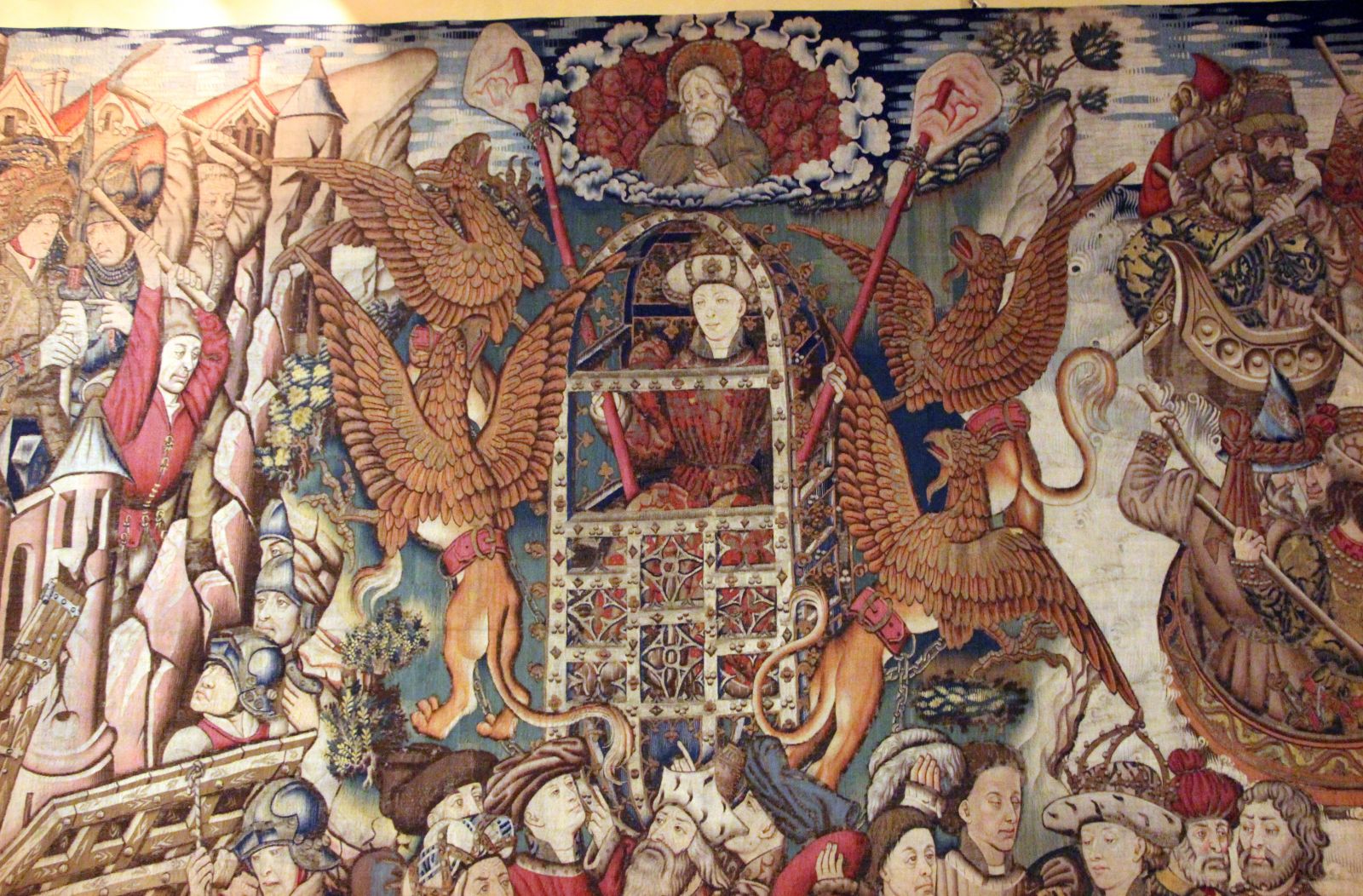Sons of Mars and the heirs of Prometheus – the conquest of the heavens: war and technology
An interpretative essay on Plate C of the Mnemosyne Atlas
Edited by Seminario Mnemosyne, co-ordinated by Monica Centanni, Giulia Bordignon, Silvia De Laude, Daniela Sacco
English version by Elizabeth Thomson
Italian Version | Abstract
§ Appendix I. Materials for Panel C before Panel C
§ Appendix II. The Zeppelin airship: notes on the history of an iconographic adventure, from the First World War to Panel C of the Mnemosyne Atlas
Introduction
Panel C is one of the opening group of Panels tagged A, B and C respectively. They stand alone, as indicated by the use of letters of the alphabet rather than Arabic numerals, and offer a gateway to the possible routes for interpreting the Atlas (for the opening to the Atlas, see the essay Iter per labyrinthum; for the genesis of Panels A, B and C, see De Laude 2015).
Panel A introduces the discourse of the migration of ancient divinities in the geographical and cultural area which has at its centre the Mediterranean, suggestively relating it with a genealogical line, the flourishing family tree of the gens Tornabuoni, a model Medicean family of the Renaissance.
Panel B illustrates the relationships between Man and the Cosmos during the transition from the Middle Ages to the Modern era, showing two paths, one governed by the celestial powers that control the lives of Man, and vice-versa, one that demonstrates Man’s control over the world.
The cosmos is the universe represented, measured, and conquered by the téchne which in Panel C is the new way to knowledge and orientation, although it reveals by contrast its potential for destruction. The A, B and C group is followed by a detailed and chronological analysis of the routes through of the Atlas heralded in the opening Panels. Panel 1, indeed, presents once again the theme of astrological representation and orientation, considered in the light of reading and decoding: the chosen medium is hepatoscopy, a method of divination practiced from Babylonia to Etruria.
Interpretive essay of Panel C in the Mnemosyne Atlas
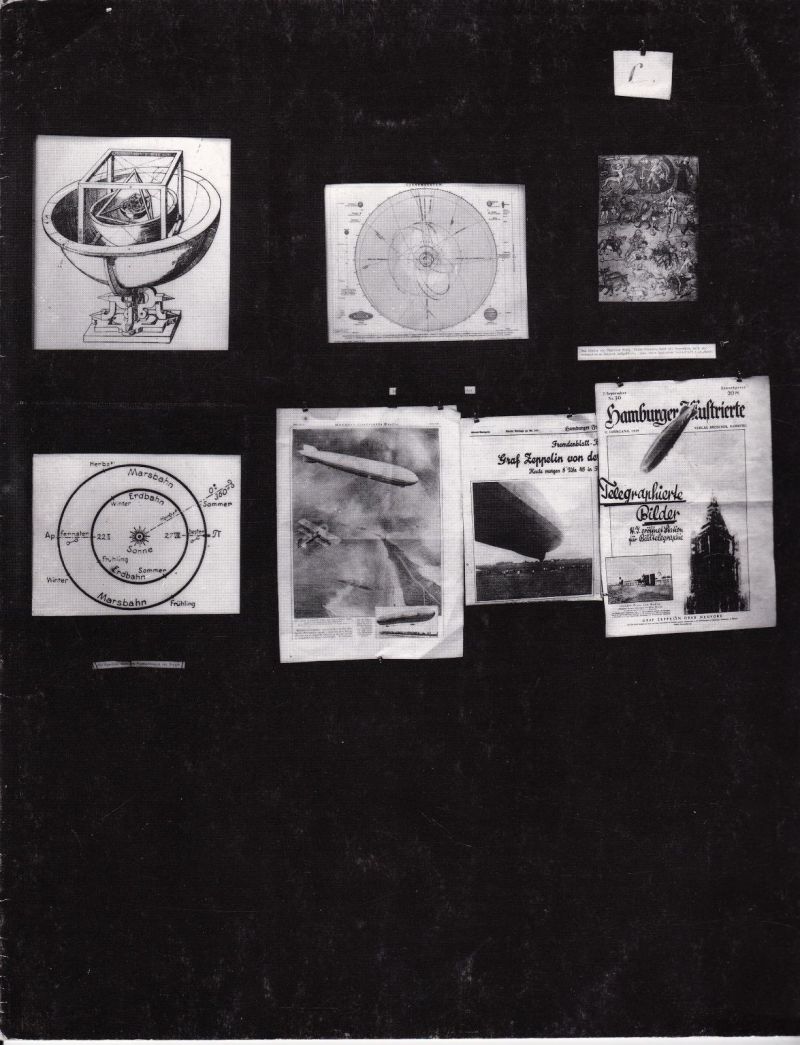
Panel C has an apparently linear and progressive layout: from the earliest conquests of modern science (the representation of planetary orbits, their trajectories and measurements based on Kepler) to its latest achievements (the transmission of images via telegraphy). The focus is on the power of the various means of representation and reproduction (machinery of technology) and on the resulting enhanced ability to transmit figurative ideas (“pictorial slogans” is an expression of Warburg’s and refers to the circulation of images, RPA 622). The layout of the six images occupies just a part of the upper region of the Panel (it should be remembered, however, that the 1929 version of the Atlas was a dummy run), and follows a dialectical rather than a linear sequence.
The image top left (Kepler’s mechanical model for studying and representing planetary orbits) and the final one bottom right (the photograph of the flight of the Zeppelin airship transmitted via telegraphy) do not function as the obligatory incipit and explicit of the figurative argument; nor can one identify, as in other Panels, a focal image around which the syntax of the Panel revolves. The first image top left (C1) is an illustration of the planetary orbits with regular geometrical solids from Johannes Kepler’s Mysterium cosmographicum (1596). Continuing clockwise, the second image (C.2) illustrates the planetary orbits in accordance with modern concepts, via an illustration in an encyclopaedia dated 1895.
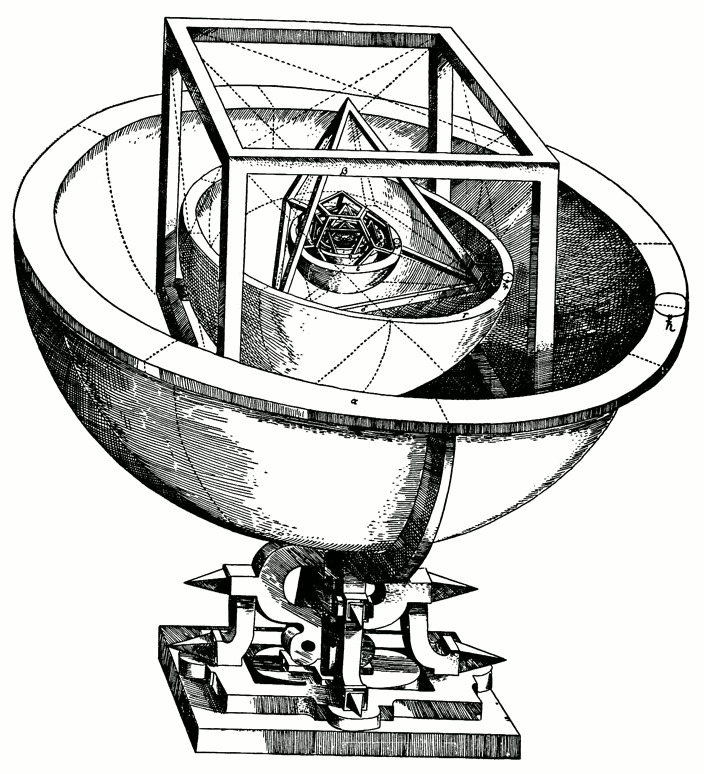
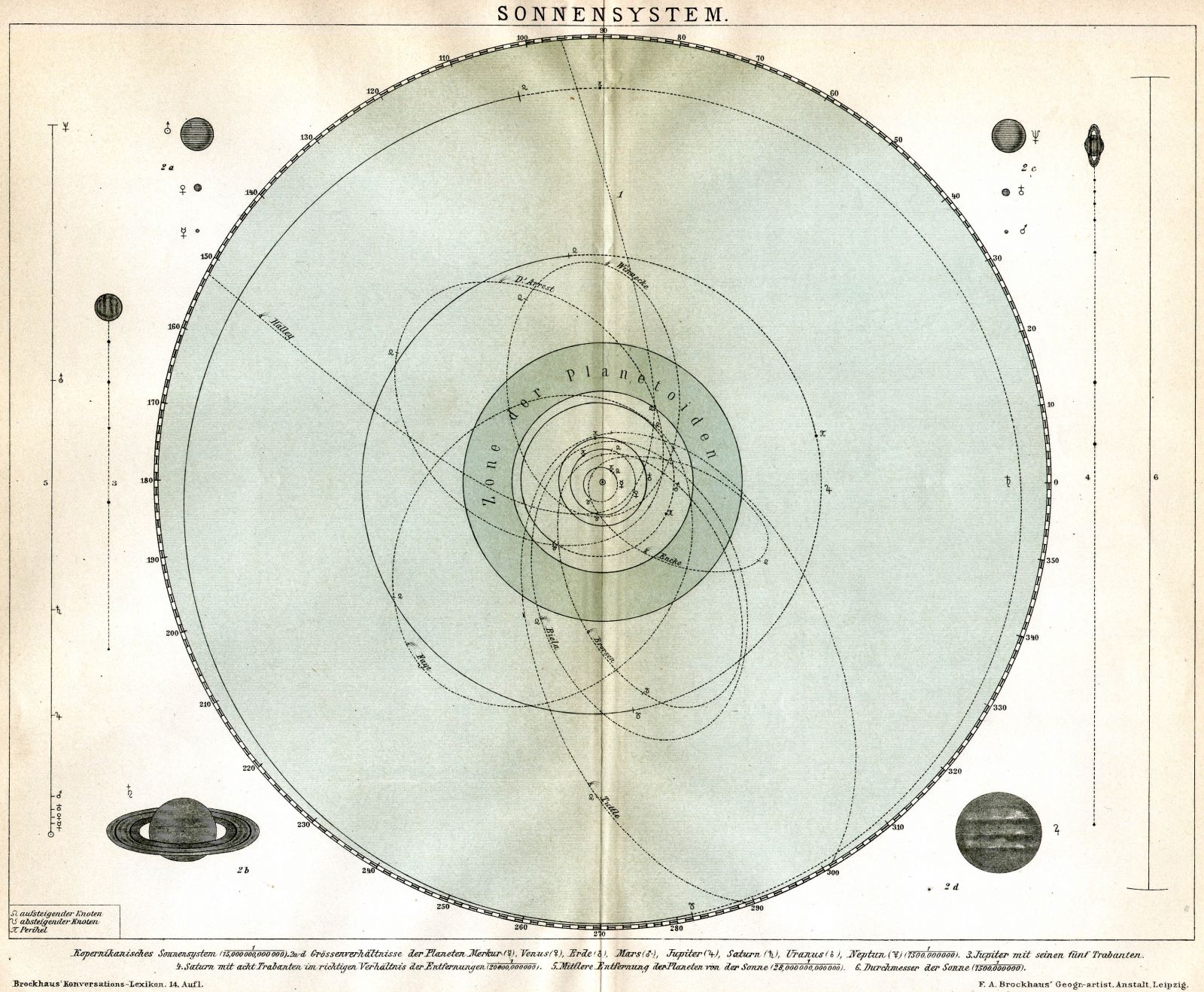
C.1 | Planetary orbits associated with regular solids from Mysterium cosmographicum (1621) (caption by KBW), from Johannes Keplerus, Mysterium cosmographicum, Tübingen 1621.
C.2 | Planetary orbits in accordance with modern concepts (caption by KBW), illustration from Brockhaus, Konversations-Lexikon, 14th edition, vol. XV, Mannheim 1895.
The next image, third right (C.3), is a miniature from a codex dated to the second half of the fifteenth century conserved in Tübingen. It features the Sons of Mars, or more precisely, in accordance with astrological notions of the Hellenistic era, those born under the influence of Mars, their trades, inclinations, and activities: Perseus is an exemplary mythical figure, here represented “half constellation and half European warrior” (as described in the caption below the image in the Panel). The figure that follows bottom left (C.4) represents a diagram of the orbit of Mars in accordance with a passage from Kepler’s Astronomia Nova (1609).
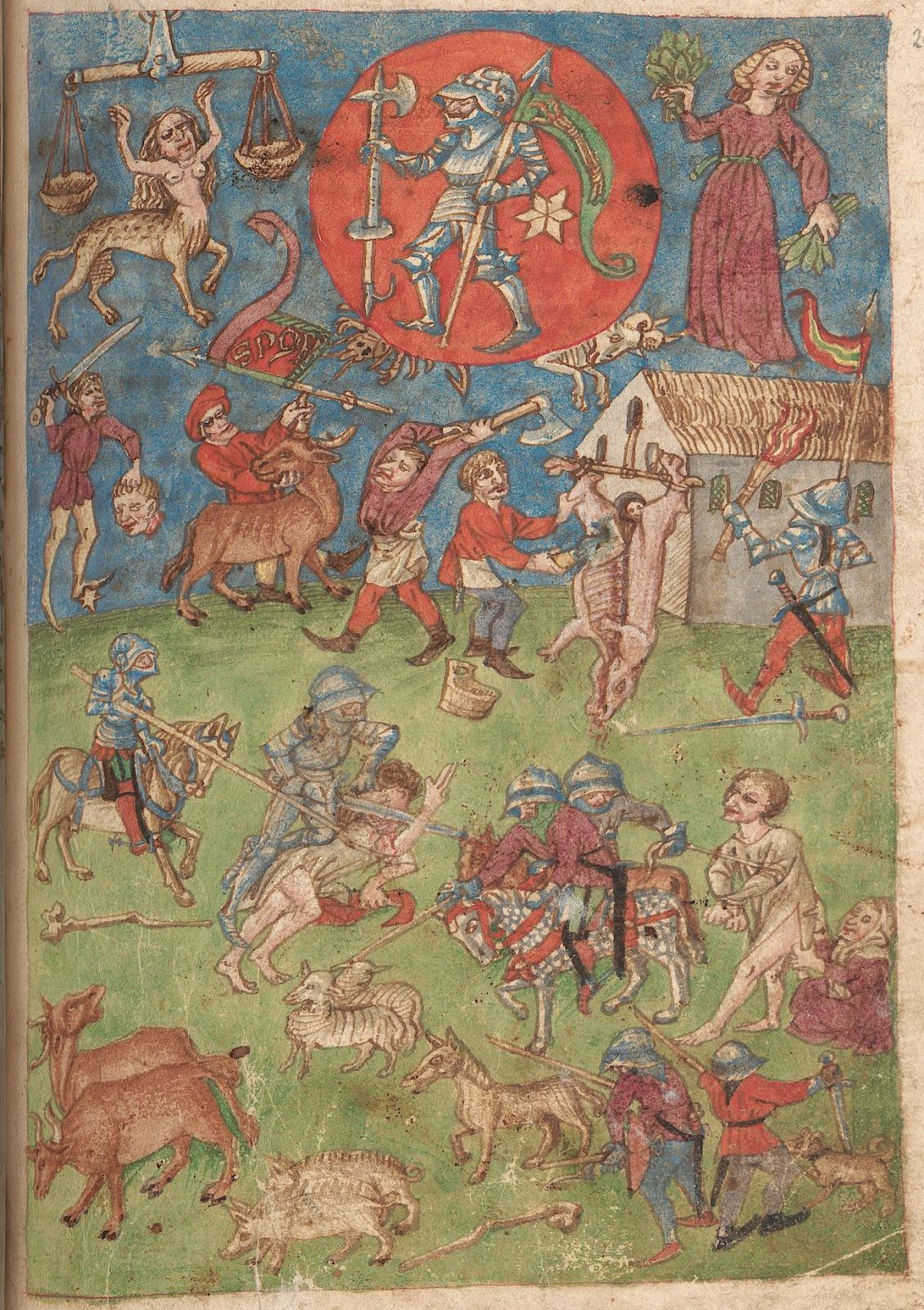
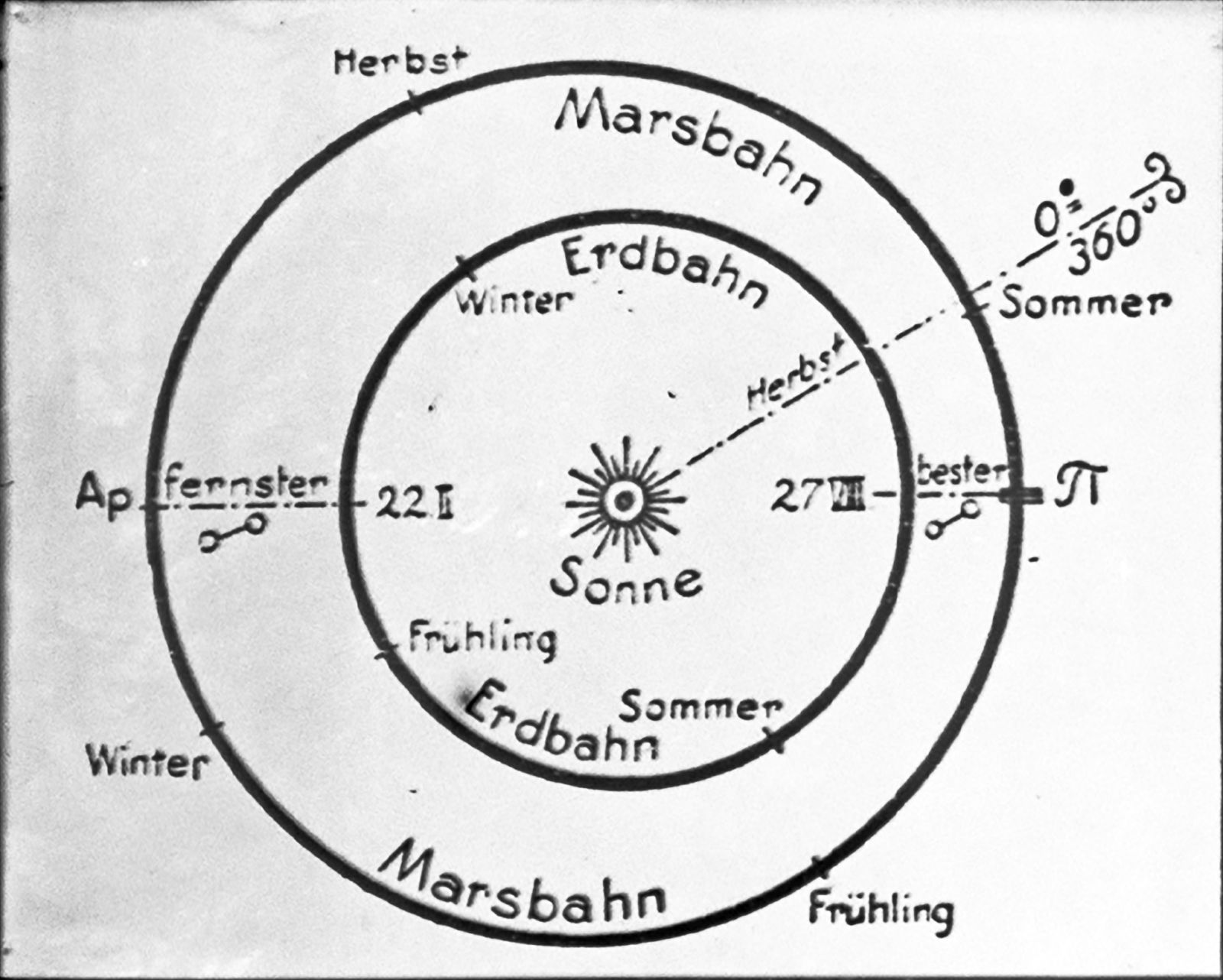
C.3 | The Sons of Mars; on the left: Perseus, conceived in equal parts as a constellation and as a European warrior (from a C15th German manuscript [caption by KBW], from Kalendarisches Hausbuch of Master Joseph, Cod. M. d. 2, 1475 ca., fol. 269r, Tübingen, Universitätsbibliothek.
C.4 | The Orbit of Mars in accordance with the observations of Kepler [caption by KBW], diagram according to a passage in Astronomia Nova by Joannes Kepler.
One of the thematic threads of Panel C is, therefore, the representation of Mars as a model case of the conceptual trajectory that, via the catasterisation of the divinity, leads western thought, from the beginning of the Hellenistic age, per monstra ad sphaeram to identify the demonic nature of Mars with a physical body in the heavens – one of the planets that governs the celestial spheres. The profile of the pagan divinity is recognisable in the peregrinations of the name and numinous power of Mars from the cosmos to earth, and from earth to the sky, and again from heaven to earth in the alternating phases of astronomical allegoresis that are conferred upon the god. The emphasis of this progression that foreshadows a detachment from the notion of the anthropomorphic image of the god in favour of a scientific rationalisation of his power and his influence is made clear in Warburg’s note regarding the Panel:
Entwicklung der Marsvorstellung. Loslösung von der anthropomorphistischen Auffassung. Bild – harmonikales System – Zeichen.
Evolution of the concept of Mars. Detachment from the anthropological concept. Image – harmonic system – sign.
Kepler’s studies and theories of the orbit of Mars around the Sun – which Kepler himself discovered is elliptical rather than circular as pre-modern astrology would have it – signals in the history of thought a decisive rejection of theories of the influence of planetary divinities on its own ‘sons’. Fritz Saxl writes:
Kepler, who by replacing the circle with a geometric ellipse established the orbit of Mars, is for Warburg a symbol of those forces that create a space for thought (Saxl [1930] 2002, 138).
One could, therefore, at first viewing, read in Panel C the history of a progression towards a rationalisation that begins with the concept of archaic demons and culminates with a vision of modern science. The theme of Panel C is, in fact, the revolution that Kepler brings to the field of mathematical astronomy, together with the simultaneous survival of the magico-demonic aspect of planetary influences, and the power of Mars in particular. The montage opens with technical and scientific images from the modern era: engravings that represent planetary orbits, especially the elliptical orbit of the planet of war that contradicts the composure of the Thomistic representation of the cosmos founded on concentric spheres. However, in Panel C, one factor breaks the chronological sequence and contradicts the formal uniformity of the montage: the inclusion of a manuscript page portraying the Sons of Mars (C.3) gives way to an eccentric image compared with the others in the Panel – eccentric also in terms of support, technical execution, and chronology.
The thematic link between the manuscript page and the other images is to be found in the kind of consideration that Warburg reserves for astrological science: detaching himself from enlightenment doctrine, the scholar acknowledges that astrology contains a form of ‘scientific knowledge’. The ancient divinity, catasterised as a planet, is seen as a figure that represents the cosmos, a “sign” (as Warburg describes it in his note) of the concept that corresponds with the need for rationalisation, albeit stated in a magico-superstitious key. The name of Mars, in his planetary equivalent, maintains his ancient demonic power and has physical influence on the character, aspect and aptitudes of Man; at the same time, acknowledged as planets or designed in the heavens as constellations, the personalities of the ancient gods and demons are adopted by Man as useful points of orientation in the cosmos (see the image that opens the whole atlas on Panel A: the astrological and astronomic map with the constellations depicted as splendidly colourful monstra populating the Celestial Vault).
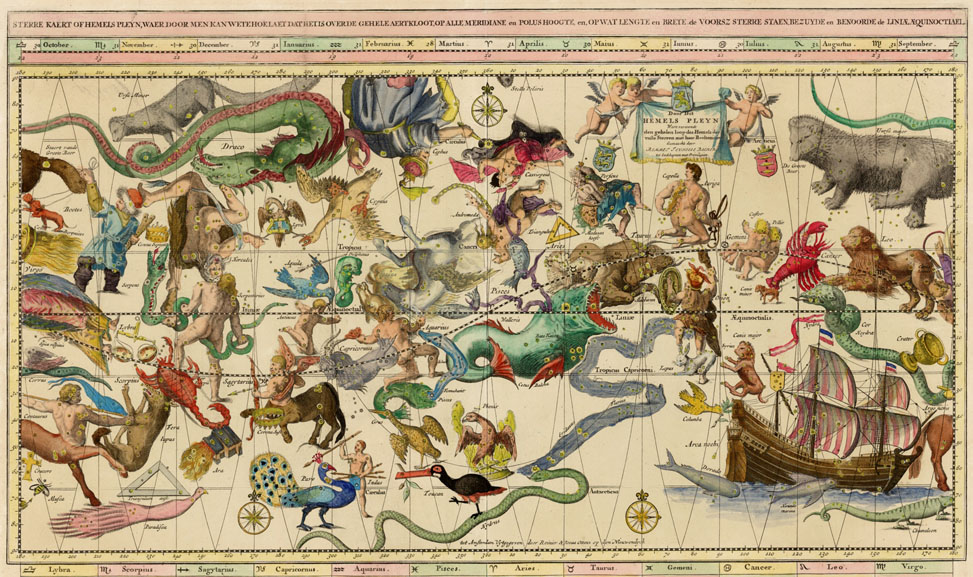
A.1 | Representation of the sky with constellations, coloured etching on copper, Holland 1684, Hamburg, Planetarium.
The inclusion on the panel of three cuttings from newspapers and journals is also significant: the material drawn from contemporary documents makes the reflection on the power of science and orientation in space topical, via images of the technological conquest of the sky and the ether - the airship and the telegraph. The subgroup of figures C.5, C.6, C.7 consists of photographic images of the Graf Zeppelin, the airship that, in September 1929, (the date of the last version of the Bilderatlas) accomplished the first circumnavigation of the world.
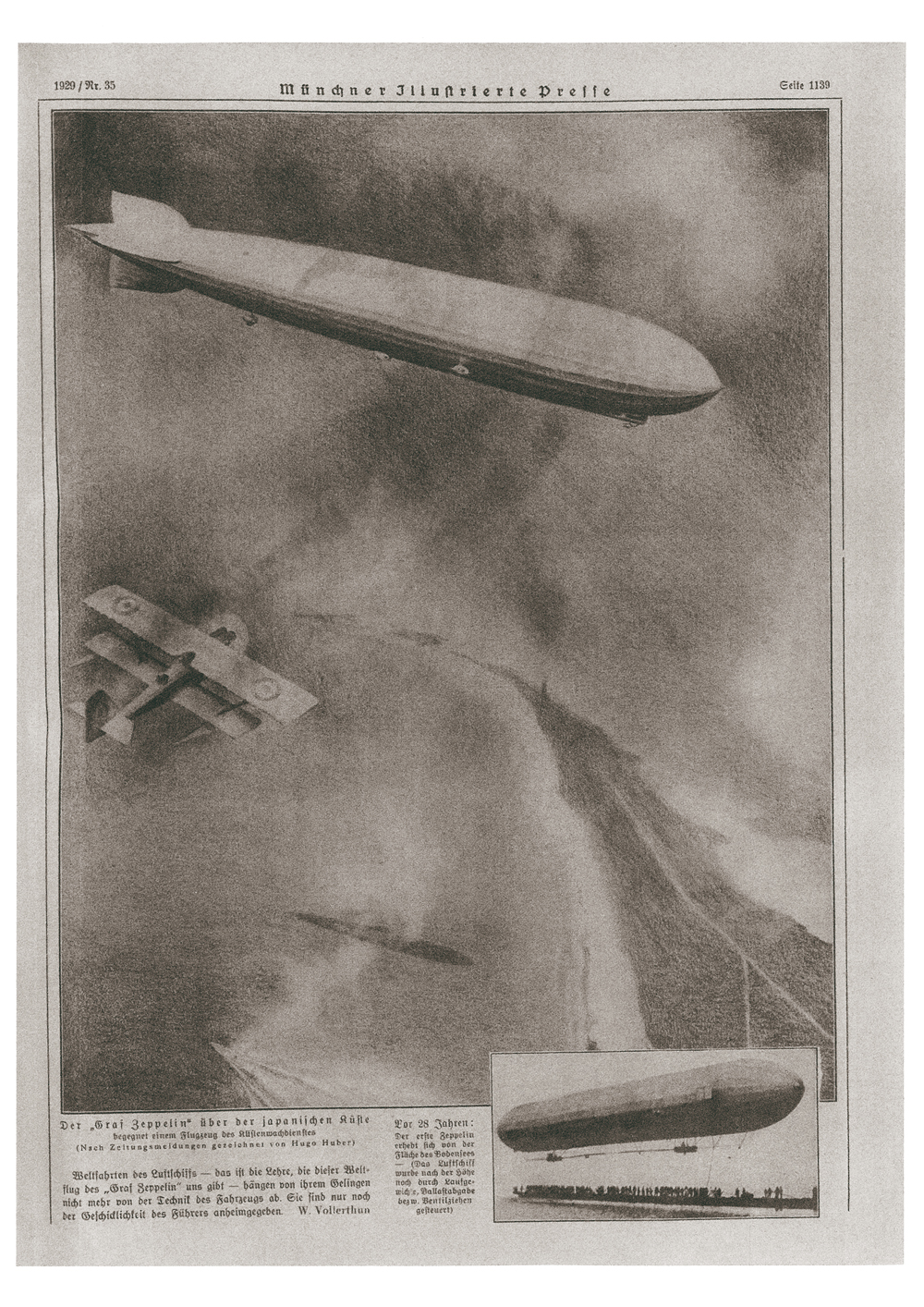
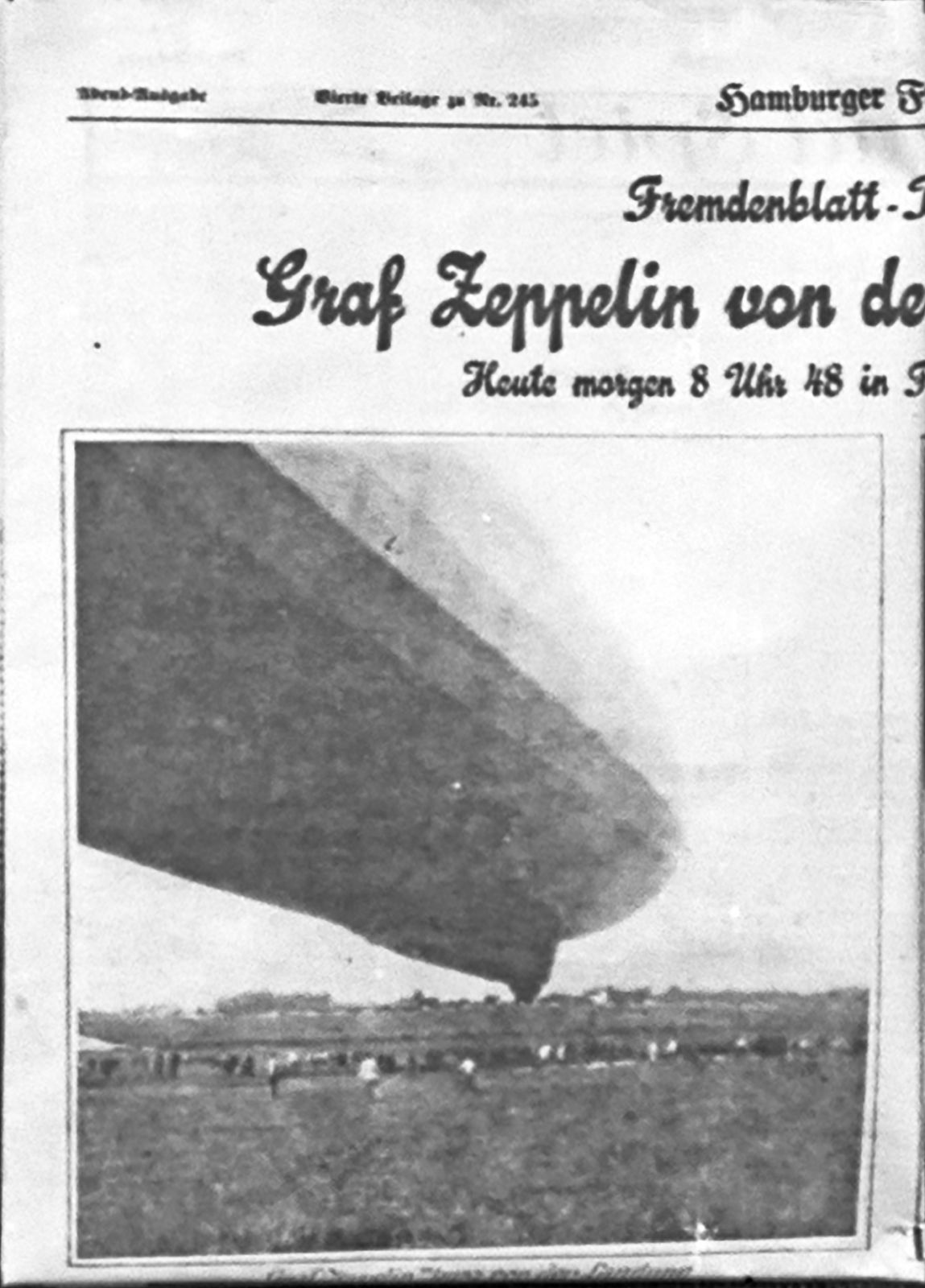
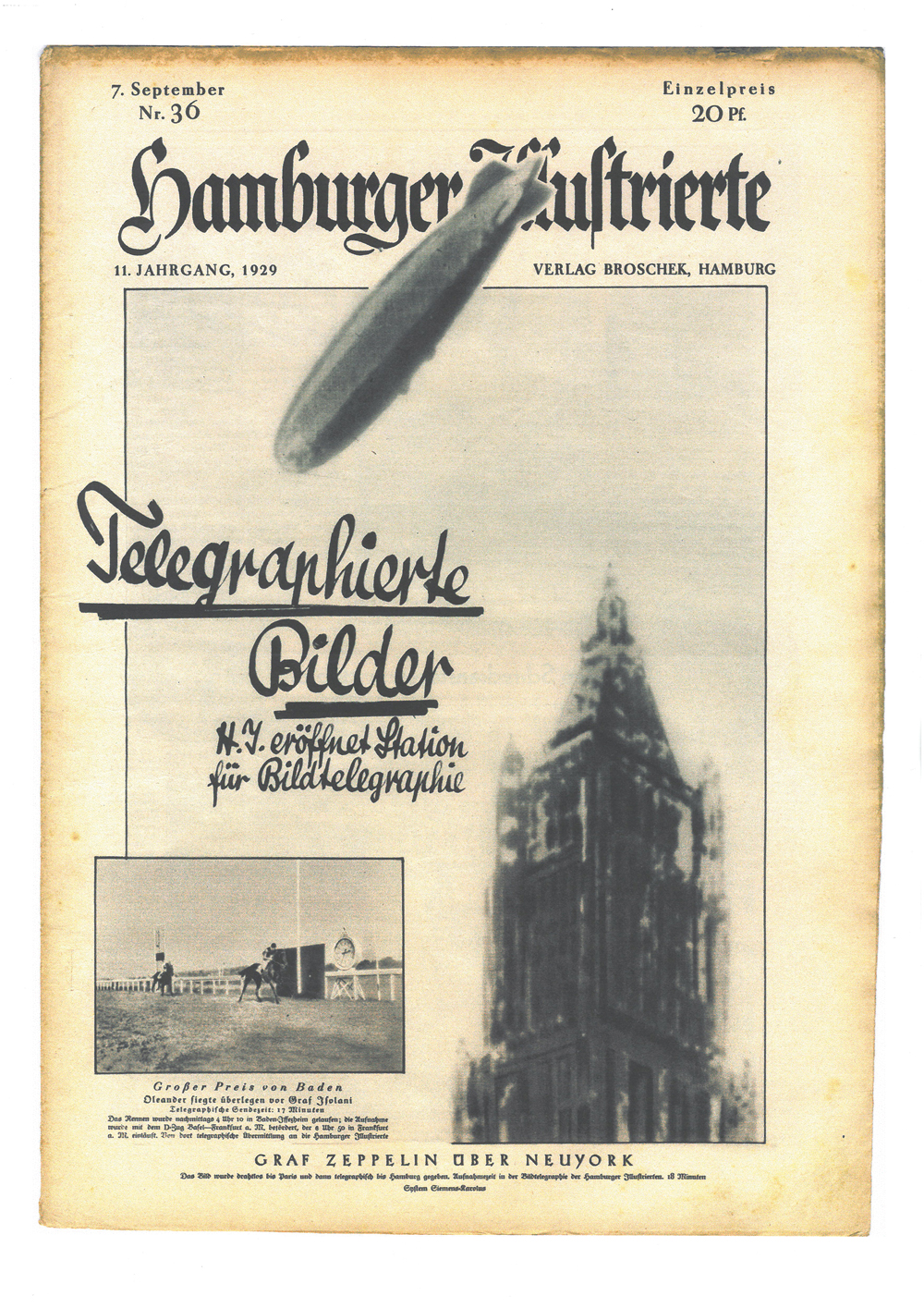
C.5 | The Zeppelin flying over the Japanese coasts crosses an airplane of the coastguard, drawing from a press-release photograph, “Münchner Illustrierte Presse” 35 (1929), 1139.
C.6 | The Zeppelin landing at Friedrichshafen, illustrated page from the “Hamburger Fremdenblatt” 245, evening edition of 4 September 1929, 17.
C.7 | Telegraphed photographs [title of the image], photograph of the Zeppelin above New York, page from “Hamburger Illustriert” XI/36, 7 (September 1929).
Panel C, then, at first sight, presents the progress of technology that appears to prove true the positivistic belief of the triumph of Man over superstition in demonic influences and the awesome forces of nature. From what emerges from the fragments of his diary, Warburg had been impressed chiefly by the manoeuvre carried out by the crew of the airship to avoid a frightening storm signalled in time by modern on-board instruments; he, in fact, noted significantly:
Die Queckersilbersäuler als Waffe wider Satan Phobos.
The mercury column as a weapon against Satan Phobos.
Annotation in his diary of 10 September 1929 (Warburg [1926-1929] 2001, 523).
From the early 1920’s, in fact, the Zeppelin – originally planned as a military weapon and for this reason used in the first aerial bombardments – had been converted to civilian uses – for exploring the world, and connecting America and Europe.
I. Orientation and the conquest of the cosmos
In a logical sequence, not necessarily chronological, Panel C describes the progressive acquisition of technologies that enable man to understand and represent the cosmos, and therefore to orient himself within it. From Kepler’s instruments, theoretical and practical, right up to the flight of the Zeppelin airship, the way is opened for man to conquer a new dimension decisive for modernity: airspace.
Panel C opens with an illustration taken from Johannes Kepler’s Mysterium Cosmographicum (Tübingen, 1596): the design proposed by Kepler is in keeping with what until then had been considered uncontested law regulating the solar system - the uniformity, regularity, perfection, and circularity of the motions of celestial bodies, governed by physical laws conceived as subordinated to divine and transcendental principles. In this sense, Kepler, by revealing the results of his early studies on the order of the universe and the solar system, had suggested a symbolic representation of the harmony of the spheres and a system of regular solids nesting one within the other. Each of these solids, in accordance with Pythagorean and Platonic theory, governed and represented a celestial sphere; in this sense, God created the world and the disposition of the heavens in the form of five regular solids: cube, tetrahedron, dodecahedron, icosahedron and octahedron.
Warburg had already considered the matter of Kepler’s identification of planetary orbits with regular bodies in Mysterium cosmographicum, in 1925 in his commemoration of Franz Boll, author of Sphaera barbarica (1903), dedicated to Hellenistic astrology and the astrology of late antiquity (Warburg [1925] 2012, 381-385; Panel 50, 384). Referring to the image that appears on Panel C top left, Warburg writes:
Regarding the Celestial Vault, one could say that the Promethean tragedy of man lies in this: above us there is no stable firmament […]. In Kepler’s Mysterium Cosmographicum, 1956, there is an image, emblematic of the harmony of the spheres, a system of regular solid bodies, nesting one within the other. Each of these regular solid bodies, in compliance with the Pythagorean doctrine found in Plato represents a sphere […]. But with regard to Mars itself – as Kepler surely acknowledged – the system understood until then no longer sufficed, the system that placed the circle as the unit of motion as the basis for the motions of the planets. The ellipse was unknown to mathematical cosmography.
The laws governing the structure of the cosmos are to be found by circumscribing and inscribing the orbits of the planets in the geometric solids, starting from the Earth which is the unit of measure for all the orbits, and which in turn rotates around the Sun. However, Kepler, starting with the empirical observation of the orbit of Mars which he discovers is elliptical, acknowledges that the ellipse characterises the orbits of all the other planets; therefore, in his Astronomia Nova of 1609, from which the second image on Panel C is drawn, Kepler verifies the irreconcilability of this theory with the empirical data of astronomical observation. As a result, the astronomer decided to study the motion of planet Mars, and introduced a decisively new unit of the orbit’s motion: the ellipse.
The ellipse was thus included in the cosmophysical image, breaking with the notion bequeathed from antiquity that placed the circle and the sphere at the centre of the configuration of the cosmos. Warburg writes:
The ellipse had not yet entered mathematical cosmography. It was clear to me that here there must have been some difficulty for the West during the early Middle Ages. It concerned overcoming primitive fear applied to mathematics, which prevented the construction of celestial bodies in a manner that did not conform with the ideals or requirements of earthly human commensurability. In truth, Giordano Bruno had already hurled a stinging and hard-hitting attack against the crude humanisation of the planets and their associations with pagan divinities. On the other hand, it was easier to reject monstrous illusory anthropomorphic images than give up the claim that the unit of motion of planetary orbits should be harmonic in the sense of organic human duplicity, because, to a great extent, this ideal of apparent regularity facilitated orientation (Warburg [1925] 20143, 100-101).
On display is the first scientific schematisation (astrological), of one of the themes of the Panel: the need, seen throughout all the images, to sketch diagrams enabling man to find his way through the cosmos. The thematic thread of orientation permeates the structure of the Panel: all the images are connected to the gradual acquisition of a “coherent image of the cosmos” (Kurt Forster’s words), that comes about as a result of the projection of one of Kepler’s theoretical configurations.
Warburg sought confirmation of his considerations on the influence of Kepler and his theory of elliptical motion on modern science from Ernst Cassirer. The theme of astronomy had indeed been the subject of their first direct encounter in April 1924 at Kreuzlingen, where Warburg had been admitted. Cassirer confirmed Warburg’s notion that Kepler could be considered a figure of transition – “Übergangstype” – between the pre-modern era and modernity. Cassirer’s authoritative reassurance of his intuitions being correct was therapeutically decisive for Warburg – he addressed his research with greater confidence, and it contributed to convincing Warburg that he was ready to return to his studies and his life outside the clinic directed by Ludwig Binswanger. The two intellectuals, both engaged with examining the roots of the science of culture, agreed in conceiving “conceptual logic” and “imaginative causality” as functions of one single “faculty of orientation” (Warburg [1928] 2008, 755-764, AWO I.2).
In his commemoration of Boll in 1925, Warburg recalled that Kepler had been in great difficulties in his study of the orbit of Mars, and had consulted the mathematician Fabricius:
Kepler was aware that entering a new era, that signified overturning Sphaera barbarica both inside and out, depended on the ungovernable functioning of his conscience as a researcher, which could not be appeased, not even in the face of eight degrees of error in the calculations of the orbit of Mars. Despite this, he talked of planet Mars as of an ancient priest whose scattered followers we can see in an illustrated codex in Tübingen (Warburg [1925] 2014³, 387 and Panel 351).
Warburg’s words and tone reveal not only his admiration for, but his self-identification with, Kepler, together with the difficulties the astronomer had encountered in his research, his methodological doubts, and his unease that opened the way to new, revolutionary, discoveries: a self-identification that passes for the attraction that even Warburg feels towards Mars, and its violent influence that he had to keep under control. Again, during his commemoration of Boll, Warburg quotes a passage from Astronomia Nova in which Kepler maintained that he had succeeded in governing the unease of Mars, negotiating with him, and calming his violence. Kepler writes:
Mars has long resisted the pains of astronomers, but the great warrior Tycho sought and catalogued over twenty year periods of watching all his warrior cunning. Encouraged by his example, I, Kepler have sought to establish with certainty the positions in which Mars is found using Tycho’s instruments, and, with the help of mother earth, I have tamed all his flaws. In the end, Mars acknowledged my courage, gave up his hostility and has shown himself loyal (Johannes Keplero, Astronomia Nova ΑΙΤΙΟΛΟΓΗΤΟΣ seu physica coelestis, tradita commentariis de motibus stellae Martis ex observationibus G.V. Tychonis Brahe, 1609, 117 quoted in Warburg [1925] 20143, 102-103).
Thus, even though Kepler embodies by antonomasia, as Saxl says, the figure of the scholar able to conquer a – progressive but never definitive – Denkraum (space for thought), it is the astronomer himself who perceives and transmits, by his own affirmations, the power, not only symbolic but also figurative, of the Mars of late antiquity and the Middle Ages – the ferocious demon warrior, that comes down to us through astrological imagination.
For Warburg, with more encouragement from Cassirer, who at the start of his career had written a book on him, Einstein, was the “new Kepler,” whose theory of relativity he praised highly. During the encounter that Warburg succeeded in organising with the scientist in 1928 at Scharbeutz, he sought confirmation of the notion of Kepler as a figure of transition and showed some of the images that would later be assembled in Panel C, pinning them to the curtain on the veranda where the two sat, as though it were a Panel in the Bilderatlas. Together with the notion of ambivalence associated with the star sign, between the polarity of magic and astrology, and astronomy and mathematics, Warburg sought a juxtaposition concerning the idea of the relativity of aesthetic values, which he introduces with the concept of “Relativität des Kunstbildes”. Despite being happy with the encounter, the extent to which Einstein agreed with or understood the art historian is not clear, even though Claudia Wedepohl and Hors Bredekamp acknowledge in an article written by the scientist and published in the “Frankfurter Zeitung” on the third centenary of Kepler’s death, an echo of the encounter that took place just two years earlier. A sketch drawn by Einstein to explain to Warburg the elliptical motion of Mars and the importance that he ascribes to the ancients as precursors of Kepler – a sketch that was later found in Warburg’s archive – is, according to Wedepohl and Bredekamp, obvious evidence of the exchanges occurring between the two at Scharbeutz (Wedepohl, Bredekamp 2015, 56-59).
The antagonist of the spherical perfection of the cosmogony of the ancients is, therefore, Mars, and the figure of the ellipsis is the figurative constant implicit in the Panel, from the shape of the orbit to the profile of the airship. The discovery of the elliptical orbit of the most intractable of the gods-planets paradoxically helps in designing a new cosmic structure that guarantees more precise, more scientific options of orientation. This is the prerequisite for the conquest of the cosmos by man, and occurs as a result of the invention of machinery that is increasingly technologically advanced: instruments and devices for studying and measuring (astrolabes, modern astronomic atlases, on board instruments), vehicles (airplanes, airships), and the means of capturing and transmitting images through the ether (photography, the telegraph).
In Warburg’s vision, therefore, the catasterism of Late Antiquity (and later, of the Middle Ages and the Renaissance) can be considered as an impulse to reconciliation between the earth and the sky and, above all, as an attempt to know and take possession of the cosmos. By including in Panel C the eccentric item, the miniature painting portraying the Sons of Mars, Warburg achieves the principal effect of giving this Panel a theoretical value and a complication of meaning that is in tune with the polysemy that distinguishes all the montages in the Atlas.
A marginal note: Warburg discovers in the ellipse, which with its twin focus points opposes the ‘monotheism’ of the sphere, a cypher that happily corresponds with his theory of polarity. The elliptical form returns, forcefully, in the project for the Kulturwissenschaftliche Bibliothek Warburg in Hamburg, a project in which Warburg takes part directly with the architect, especially in the configuration of the “oval room” of the Institute (on the KBW project, see in Engramma Calandra 2014).
II. Diffusion and circulation of images
A further theme that unites the images in the Panel is the diffusion and channelling of images, especially from the aspect of technical reproduction: the relationship of Man with the cosmos, according to Warburg’s notes, passes from anthropomorphic image to “sign”, in the form of the representation of the harmony of the spheres until it becomes an abstract cypher (which is what happens to the image of the Zeppelin, which covers great distances because of the technology of telegraphy), in accordance with the discourse that animates the theme of transmission in the images in Panel A.
The image of Mars and his sons had already been shown during the commemoration of Boll, as was an image drawn from the Brockhaus Encyclopedia (1895): what was sought was the contrast between the image of the “scattered sons” of Mars, and the calming, ascetic representation of the planetary orbits according to the concept shared by contemporary science. The selection of an image taken from the most widespread German Encyclopaedia (something akin to Wikipedia today), and being able to identify its provenance has further meaning regarding what the image illustrates (“Planetary orbits in accordance with modern concepts”): control of the cosmos, knowing it rationally, does not yet cancel the persistence of the monsters sustained by superstitious thought.
In his essay, Pagan-Antique Prophecy in Words and Images in the Age of Luther of 1920, Warburg engaged himself with a large fish that had appeared in the sky in 1524 and had been reproduced by Leonhard Reymann as a prophecy of an imminent universal deluge which would have come true in the sign of Pisces. The image of the great fish in the sky (which could be morphologically assimilated with the image of the Zeppelin in Panel C), had been bidden by Warburg in his essay on Luther to argue the extent to which that prophecy and the matter of Luther’s birth had been used as propaganda during the Reformation. The efficacy of the press as a new medium of circulation in the fifteenth century, with specific reference to astrological and meteorological forecasts, is emphasised by Warburg in the same essay:
Carion’s book casts significant light on the history of the press in the period. He denounces a number of sensational illustrated publications as attempts to manipulate the Diet of Worms through the deluge scare propaganda of Seytz and his like. We sense the impact of woodcut illustration as a powerful new means of working on an uneducated public (Warburg [1920] 1999, 618).
In the image top right, the children of Mars can be found on a page of a manuscript of the fifteenth century. The methods of the reproduction and transmission of these ‘figurative ideas’ are juxtaposed with examples of modern techniques of channelling images, from printed illustrations to photographs of the airplane and the airship derived from the most popular German newspapers.
From the end of the fifteenth century, as engraving techniques improved, astrological subjects, too, – like the scattered children of Mars still lingering in the miniature in the Tübingen codex – find in the new medium, a way to permeate the European courts: the migration of the divinities, already begun with the process of Hellenistic catasterisation, spreads in a series of disguises, as they pass from the different styles between the courts of the North and South and vice versa (see the Wanderkarte of the Mediterranean displayed on Panel A). From the beginning of the sixteenth century, on the wings of the printing press, astrological prints reproduced in large numbers, and increasingly accessible to the wider public, were ready to become an instrument of scientific orientation and indoctrination, too.
Images of ancient demons straddle the eras of different techniques of reproduction. In this respect, on the propaganda and political uses to which astrological prophecies were put, Warburg says:
The fear of natural signs and wonders, in the heavens and on the earth, was shared by all Europe; and the press of the day exploited it for ends of its own. The invention of printing enabled images – their language an international one – to fly far and wide. These stormy petrels darted from North to South and back again, and every party sought to enlist in its own cause the “pictorial slogans” (as they might now be called) of cosmic sensationalism (Warburg [1920] 1999, 622).
In the same way, in the twentieth century, journals and photographs became functional and frequently used devices to elaborate, communicate and spread ideological propaganda at a time, like First World War, when the values of humanitas were being annihilated: it was under the sign of Mars, in times of carnage, suffering, horrors and destruction that the duty of preserving memory in an ‘international’ language that does not require translation is delegated to images (the relationship between war and techniques of reproduction of images is one of the main thematic threads of the monographic edition dedicated to “The children of Mars: Warburg, Jünger, Brecht”: Seminario Mnemosyne 2015b).
The engravings that are juxtaposed with contemporary images from tabloid papers illustrating the endeavours of the Zeppelin airship to circumnavigate the world tell the story of humanity’s attempt to measure the heavens, conquer it and govern its routes. At the same time, the inclusion of the miniature with the Children of Mars is a reminder that, despite technical and scientific conquests, it is nevertheless always necessary to take into account the dark, irrational and destructive influence of the martial character. However, just as the panel does not display the image of the fish foretelling the disaster, so the Zeppelin in Panel C is not the bomber that had sown panic and destruction during First World War. It is, rather, an instrument for the advancement of – pacific – knowledge throughout the world: the images of the airship, in reality, related to the circumnavigation of the world in 1929.
In addition, Panel C no longer displays the image of the Zeppelin shown in the Hamburg library on 25 April 1925, during the commemoration of Boll: a newspaper cutting from the “Hamburger Fremdenblatt”, 166 (17 April 1925), with the news of the bravery of a British pilot, who had succeeded in landing his airship and avoid a storm. Warburg had commented on the image referring to man’s ability to govern his fate, using the metaphor of dominion over the elements (the storm), in accordance with a theme that reappears in the Atlas in relation to the Idealtypus of the Florentine merchant and the Renaissance iconography of Fortuna (see, in Engramma, the materials and the interpretive essay on Mnemosyne Atlas, Panel 48: Seminario Mnemosyne 2011):
When it comes to controlling the elements, it would seem that increasing control over nature is inverse to the primordial demands of nature [...]. Only since sounds have been produced whose producer is invisible to the receiver, has man received at his command post dry numbers as a certain compass. Now he can fight the wind as if it were a hostile personality and come out on top, even if no tuft of hair comes within reach of Perseus’ grasp. The damaged dirigible declared it had arrived safely because it succeeded, by elaborating data, to steer itself behind the storm across the North Sea towards the British coast (Warburg [1925] 20143, 99).
Knowledge of the cosmos, and the dominion that man can exercise over it, no longer relates to metaphorical images, for example planetary divinities or the personification of Fortuna who must be seized by the hair (Perseus, the Greek hero who can grab Medusa by her hair is, according to Warburg, the pre-mintage of antiquity re-emerging in a new guise in the homo faber of the Renaissance). The representation of the world now becomes a sign: the concreteness of the gesture (“greifen”: “to seize, hold down” the ancient demons as a primordial form of control over nature), is replaced by the appropriation of a rational mind (“begreifen”: “comprehend, grasp”) in a play of words of which Warburg was fond (“greifen/begreifen”): the new concept of the cosmos and the – much more effective – mastery over it, now passes through “arid numbers” and data transmitted via telegraph signal (but, beforehand, by geometric proportions: those of Vitruvian symmetry which had enabled Leonardo da Vinci’s Man – displayed on Panel B – to impose his own harmonious measurements on the universe, together with those of Kepler’s theoretical models).
Perhaps the omission of the photograph of the 1925 airship is Warburg’s wish to simplify: the image displayed during the commemoration of Boll could have been dropped because it was a duplicate of the more topical images from 1929 newspapers. Choosing the images of the Zeppelin perhaps adds something to the discourse on the media which is central to Panel C (and the entire A, B, C group of Panels). Warburg did not intend to specifically document the shape and enterprises of the German airship; rather, he aimed to provoke reflection on images of it and their impact. A drawing from a photograph, a normal photograph, and a telegraphed photograph (in the final image one can clearly read “Telegrafierte Bilder”) frontlines not the subject of the image but the way the image was transmitted (Hensel 2011).
III. The machinery of technology
Panel C highlights the evidence of technological advances in measuring and conquering the world: from Kepler’s instruments for measuring planetary orbits – top left – to flying machines, the mirabilia – the technological marvels – of the early twentieth century.
The monstrum that appears in the skies as a new invention of the twentieth century is the airship. More specifically, the Zeppelin is a type of airship developed in Germany by its inventor, Count Ferdinand von Zeppelin, whose name is given to the most important company producing airships. The success of these airships between 1910 and the 1930s ensures that Zeppelin is the airship par excellence.
At the outbreak of WWI, in particular, the airship found employment as a bomber and altitude reconnaissance aircraft, especially after 1915 in bombardments over Paris and London. At the end of the war, after their functions as war weapons had proved to be ineffective, Zeppelins were relaunched as means of transport for civilians, and were successful as a result of Hugo Eckener, who had taken over the directorship of the company after the death of Count Zeppelin in 1917, and had promoted the advances of the airship, not only in Germany. Eckener, an able team leader and a wise promoter of his own enterprises, suggested himself as the hero of the skies and ensured Zeppelins reached the height of fame, also as instruments of geographical knowledge and means of transport for mail and tourists.
In Panel C, Warburg celebrates the enterprise of Eckener, his intelligence and his courage, and he considers him to be a symbol of man’s positive management of technology. What is more, Warburg had in mind for the adventurous navigator of the skies, the archetype of an ancient fable, brought to life in late fifteenth-century Flemish tapestries: in his essay Airship and Submarine in the Medieval Imagination (1913), Warburg reminds modern aviators, engaged as they were with the topical problem of cooling their engines, the episode recalled by ancient and medieval legends in which Alexander the Great, transported into the skies in a kind of primitive airship drawn aloft by winged griffins, “tried to cool the burning feet of his heaven-storming griffins with wet sponges” (Warburg 1913, 282).
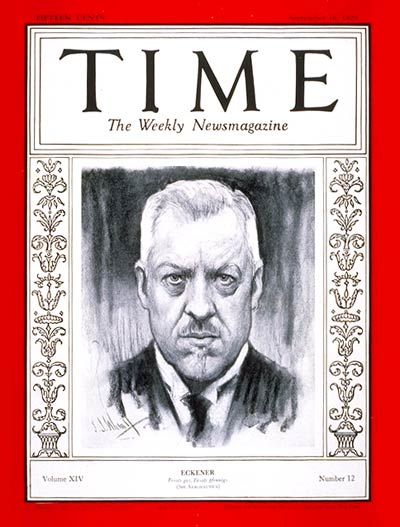
Hugo Eckener on the cover of “Time” XIV/12 (September 1929).
The Flight of Alexander, detail from Episodes of the Legendary Adventures of Alexander, Flemish tapestry, 1475 circa, Genova, Palazzo Doria.
Monsters subjected by Man and put to the service of technology: a reminder that antiquity participated considerably in the creation of modern Man, intent then as now on freeing himself from the fear of demons by taming, with technology, their primordial power.
However, the figure of Eckener is seen as a type of reincarnation of the Florentine merchant of the Renaissance – able to “remain at the helm” of life – towards whom Warburg felt a particular kinship, as his researches for Panel 48 of the Atlas would appear to testify: the pilot of the airship mastered the flight of the Zeppelin LZ 127 overcoming the storm by using technological instruments, such as thermometer and barometer, as had happened in the transatlantic flight in 1924.
This procedure, blind to destination and aware solely of direction, against the wind and the elements with hand on rudder, is at the same time surrender and self-limitation, which is precisely what makes Man lord of the universe (Warburg [1924] 20143, 19).
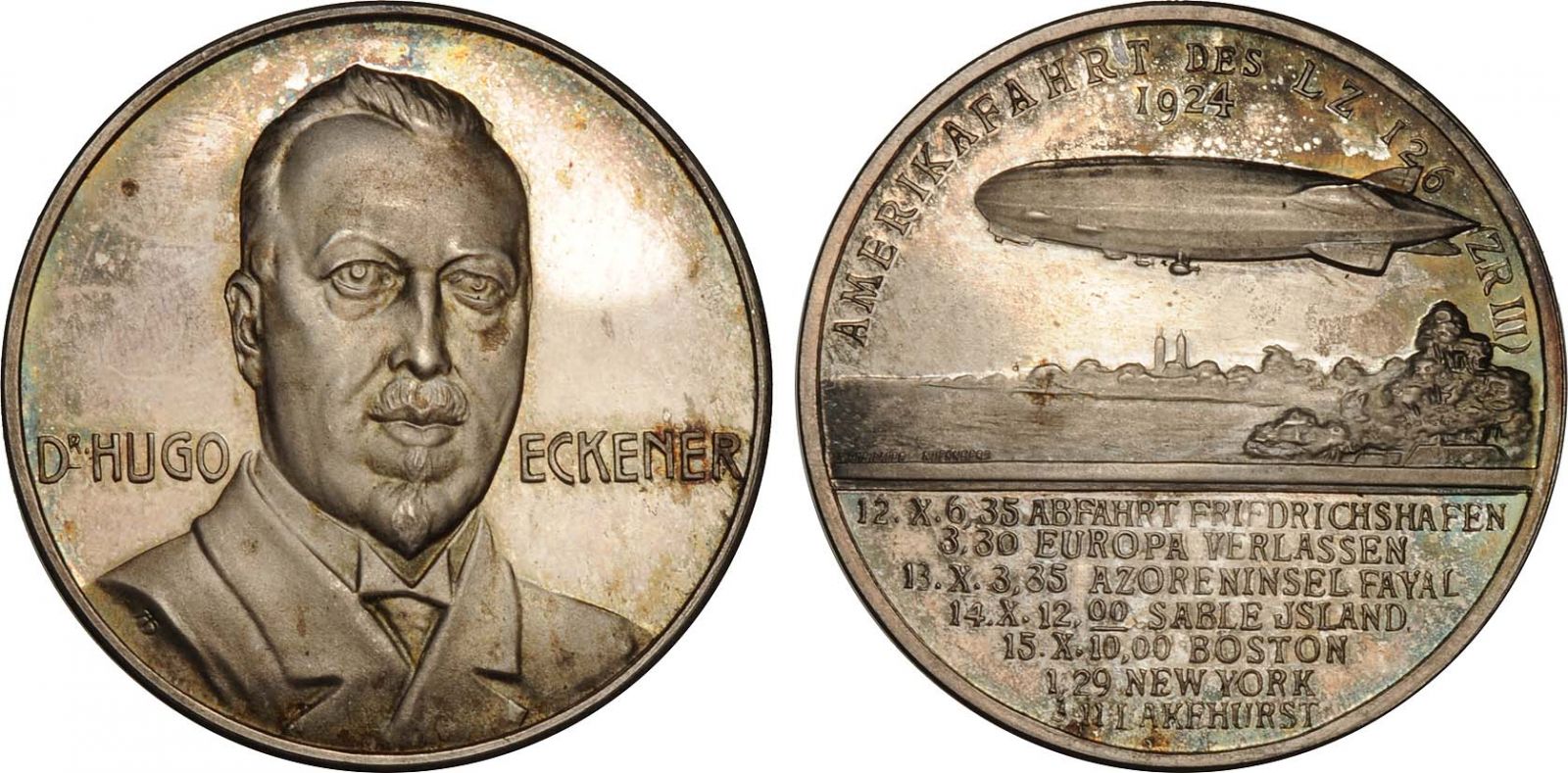
Medal portraying Hugo Eckener (1924).
For this reason, Eckener – whom Warburg had personally met in 1925, and who had in those years become a sort of national hero to the extent that he was proposed as President of Germany – could be compared with men of the Renaissance (Wedepohl 2013): from Man, the “measure of all things” drawn by Leonardo (see Mnemosyne, Panel B) to the man “who frees himself” from the powers of destiny, i.e. the merchant-entrepreneur capable of governing the ‘ship’ of Fortune. This kind of homo rinascimentalis is portrayed by an allegorical figure in a medal that Warburg inserts in Panel 48: the undertaking of the mathematician, architect (and teacher of fencing) Camillo Agrippa, is embodied in a martial figure that grasps Fortune by her forelock together with her sails, while the motto proclaims VELIS NOLISVE - “whether you will or no”, with a witty linguistic play on the Latin word “velis” (“with veils/you will”; on this pun see in Engramma, Seminario Mnemosyne 2011).
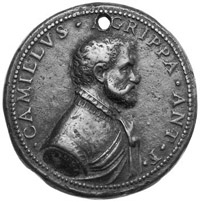
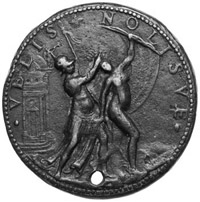
Giovan Battista Bonini, medal for the Milanese mathematician and architect Camillo Agrippa, 1580 ca.
In this respect, the works of the Milanese humanist, Camillo Agrippa - Trattato di scientia d’arme (1553), Nuove invenzioni sopra il modo di navigare (1595), Dialogo sopra la generatione de venti, baleni, tuoni, fulgori, fiumi, laghi (1584) – combine the practical disciplines of fencing and navigation using diagrams that are mathematical and geometric, and cosmological and astronomical. In 1575, Camillo Agrippa also wrote a brief treatise entitled Modo da comporre il moto nella sfera, an instruction manual to create an armillary sphere, a type of portable planetarium, that Warburg certainly had in mind when he was composing Panel C.
The heroes of this story, who with their scientific conquests, their bravery and resourcefulness, succeeded in taming the heavens are, therefore, Kepler, Count von Zeppelin and the aviator, Hugo Eckener – the last two being the protagonists of the final images of Panel C.
By placing the airship at the centre of Panel C, Warburg tells us the story of a wondrous invention while evoking its ambivalent nature: an instrument of death that can be converted to an instrument of communication between people and for the advancement of knowledge.
IV. Per monstra ad sphaeram
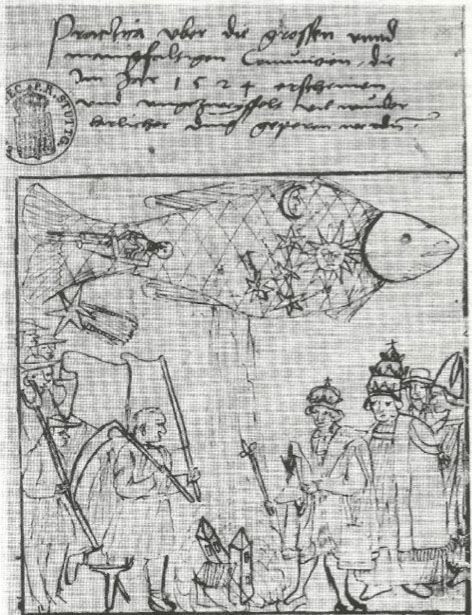
It would seem that, during the montage of this Panel, Warburg had considered including another figure that would have been a further reminder of the power of astrology, and its shift towards the numinous and superstition, which does not desist in the technological age: a fish from whose “star-studded belly (the planets in conjunction) a devastating flood descends on a city”. In his Intellectual Biography, Gombrich writes:
Now he planned to contrast a picture of the Zeppelin with that of a fish in the sky from Reymann’s prognostic. This fish was the product of fear, fear of a flood which was predicted because a number of malignant planets were to move into the sign of Pisces. Thus the projection of imaginary causes by mythopoeic thought could once again be contrasted with the conquests of ‘detached’ rational acts (Gombrich 1970, 302).
The astral sign of the fish, Pisces, drawn from the Practica by Leonhard Reymann, 1524 (Stuttgart, Landesbibliothek), that showed the constellation under which that year an inauspicious planetary conjunction would take place is included in the list of iconographic material for his essay Pagan-Antique Prophecy in Words and Images in the Age of Luther (Warburg [1920] 1999, 597). The reference to the same image in Panel C would have been a visual prompt for the observations he makes in his essay on Luther written about ten years earlier: the flying fish in the sixteenth-century illustration was a figure prophesying an inevitable natural disaster; juxtaposed with the cuttings from German journals with the confident and victorious photographs of another type of flight, it would have suggested a simple prefiguration of the new airship.
On Panel C, however, the astral fish, Pisces, is the Zeppelin: no longer a demon against which science victoriously wields weapons, but, rather, a machine designed to overpower the forces of nature and avoid its devastating effects with the use of sophisticated instruments.
However, with the inclusion of the manuscript page portraying the children of planet Mars between the two drawings of the planetary orbits according to Kepler’s theory, the montage suggests a further vital reading that inscribes Warburg’s discourse in the actual co-ordinates of the history of Europe after the First World War. The demon that science must defeat with its weapons is not simply the force of nature, or generally a case of astrological superstition that sees in the sky the signs of imminent disaster: it is Mars. The god of excess and rage is the demon of war whose sons unleash ruin and destruction on the world, but Mars is also the planet whose orbit exceeds the configuration of the harmonious motion of the planetary spheres, enabling Kepler to formulate his revolutionary astronomical theory.
Paradoxically, it is the most irrational and intractable of the gods who enables science to make a leap forward towards a theoretical, and later, practical conquest of airspace: this is the era of modernity in which the Promethean power of téchne is the ambivalent protagonist.
In the discourse suggested in Panel C, reflection on technology is undoubtedly structured and complex: the key perspective is given to us once again by the image of the children of planet Mars. Technology, a Promethean gift, confronts demons and dark powers and, at times, defeats the immanent violence of nature. However, the assault for the conquest of the cosmos launched by man, armed with his intelligence and the instruments with which he equips himself, is hybris, drifting into technological monstra, mirabilia, and formidable marvels. Technology is another form of magic, which by its nature has something to do with the same powers that it seeks to destroy.
The extraordinarily thrilling power of technology is not an unambiguous evolution towards good and knowledge: at the centre of post-war cultural debate – in a climate of collective anguish that Warburg had internalised to the extent of feeding his own mental instability – is precisely the theme of technology at the service of destruction. During the now famous lecture on the “Serpent Ritual”, Warburg concluded his excursus on the relationship between rituals-superstition-myths and technological progress on a pessimistic note against technology promising simultaneous transmission of ideas, but stating that it is the instantaneousness of communication that kills the space for thinking:
Telegraph and telephone are destroying the cosmos. But myths and symbols, in attempting to establish spiritual bonds between man and the outside world, create space for devotion and scope for reason which are destroyed by the instantaneous electrical contact unless a disciplined humanity re-introduce the impediment of conscience (Warburg [1924] 1939, in “Journal of the Warburg Institute” 2/4, April 1939, 277-292).
This is the tragic ambiguity that Warburg entertains with regard to technology and war: the imaginary conquest of a cosmic order can be invented only through the energy of demonic forces; however, that force, if not neutralised, promises to drift into destruction, under the sign of Mars.
The true protagonist of Panel C is not the Zeppelin “child of Mars” of First World War, nor the technological prodigy of modern aviation, quite so much as the virage into the portrayal and conception of technology, which once again Man attempts to convert from a destructive weapon into a Promethean device, essential for progress towards the new horizons of humanitas. Just as Kepler had been able to control Mars and overpower its demons by symbolisation, within the space of thought, so Eckener too, in Warburg’s exegetical proposal, is presented to his contemporaries in his airship like a new ‘myth’ able even to overpower and redirect the symbolic power of one of the terrible monstra of the First World War onto a positive path.
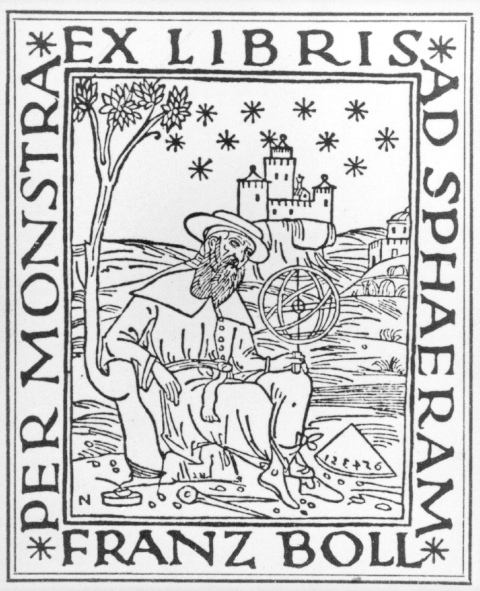
The conquest of the sky and the ether, brought about by the new theory of elliptical orbits that Kepler inferred from the orbit of Mars, and by machinery built by man, stems from prodigious inventions, and marvellous but dangerous monstra. Warburg understands this well, but unlike his conclusion to his conference on the “Serpent Ritual” in 1924, the theorem via images which he proposes in Panel C resounds with positive optimism: even after the catastrophe of First World War, it is possible to translate the destructive monstrum into a Promethean device that leads man to discover new dimensions of the cosmos, drawing him to look up and navigate the sky for the love of knowledge.
In his commemoration speech for Franz Boll, Aby Warburg recalled the motto that his friend, the author of Sphaera Barbarica, had adopted as his own insignia and appears in his ex-libris (Warburg [1925] 20143, 105; Stimilli 2013, 8-9; De Laude 2015).
The course of knowledge is tragic, and the power of technology ambivalent; however, Prometheus, apart from having given man the spark of fire, “the mother of all technai”, also gave him the gift of Hope (Elpis in ancient Greek); therefore, Warburg teaches us, “during our ascent to the ether, we must learn how to manage a carriage drawn by five horses: Daimon, Eros, Tyche, Ananke, Elpis”. (Warburg [1925] [2007] 2014³, 105). In other words, man must always discover for himself the capacity for change – theoretical and technical – and reach per monstra ad sphaera.
Appendix I – Materials for Panel C before Panel C
Edited by Silvia De Laude
The first version of the block of Panels identified by letters of the alphabet was completed for the official presentation of the Atlas at the Bibliotheca Hertziana in Rome (29 January 1929). An annotation in his diary makes it possible to be more specific – Warburg on 20 November (<recte>: October) 1929, records his idea of placing at the start of the Atlas a “methodological premise”, consisting of “about 6 Panels (A, B, C, D…)”:
Circa 80 Gestelle mit circa 1160 Abbildungen. Werde circa 6 Tafeln zur Erkenntniss-theorie und Praxis der Symbolsetzung aufstellen (Warburg [1926-1927] 2001, 551).
The notion of opening the Atlas with an introduction on methodology occurred to him when he returned to Hamburg after his study trip to Italy with Gertrud Bing. It appears increasingly more related to the work he had carried out working very closely with Saxl on the cosmos exhibition that was to inaugurate the opening of the Hamburg Planetarium. He had worked so hard on this project that he felt cheated when Mussolini inaugurated the Planetarium in Rome at the Baths of Diocletian. No mention is made of this in his Roman Diary (see Engramma, De Laude 2015, paragraphs 9-10 in particular).
As well as providing a date, the note in the diary is evidence of how the “Premise” was a work in progress, and that it would be hazardous to read Panel C as the final Panel of the introductory group of Panels added to the main Panels of the Atlas proper.
Panel C hosts materials that Warburg had used previously in exhibitions and conferences. The image of the Children of Mars in the Tübingen manuscript had been projected twice during the commemoration of Franz Boll (Warburg [1925] 2014, Fig. 27, 77): the first time to show “Perseus in the fabulous guise of Mars” (Warburg [1925] 2014³, 76); the second time to discuss the ambivalent and restless relationship that Kepler had with the god of war (Warburg [1925] 20143, Fig. 55, 102).
During the same conference, in juxtaposition to the manuscript page representing the Children of Mars, Warburg used an image taken from Kepler’s Mysterium Cosmographicum, illustrating planetary orbits identified as regular bodies. He used the same image to open Panel C (Warburg [1925] 20143, Fig. 56, 102).
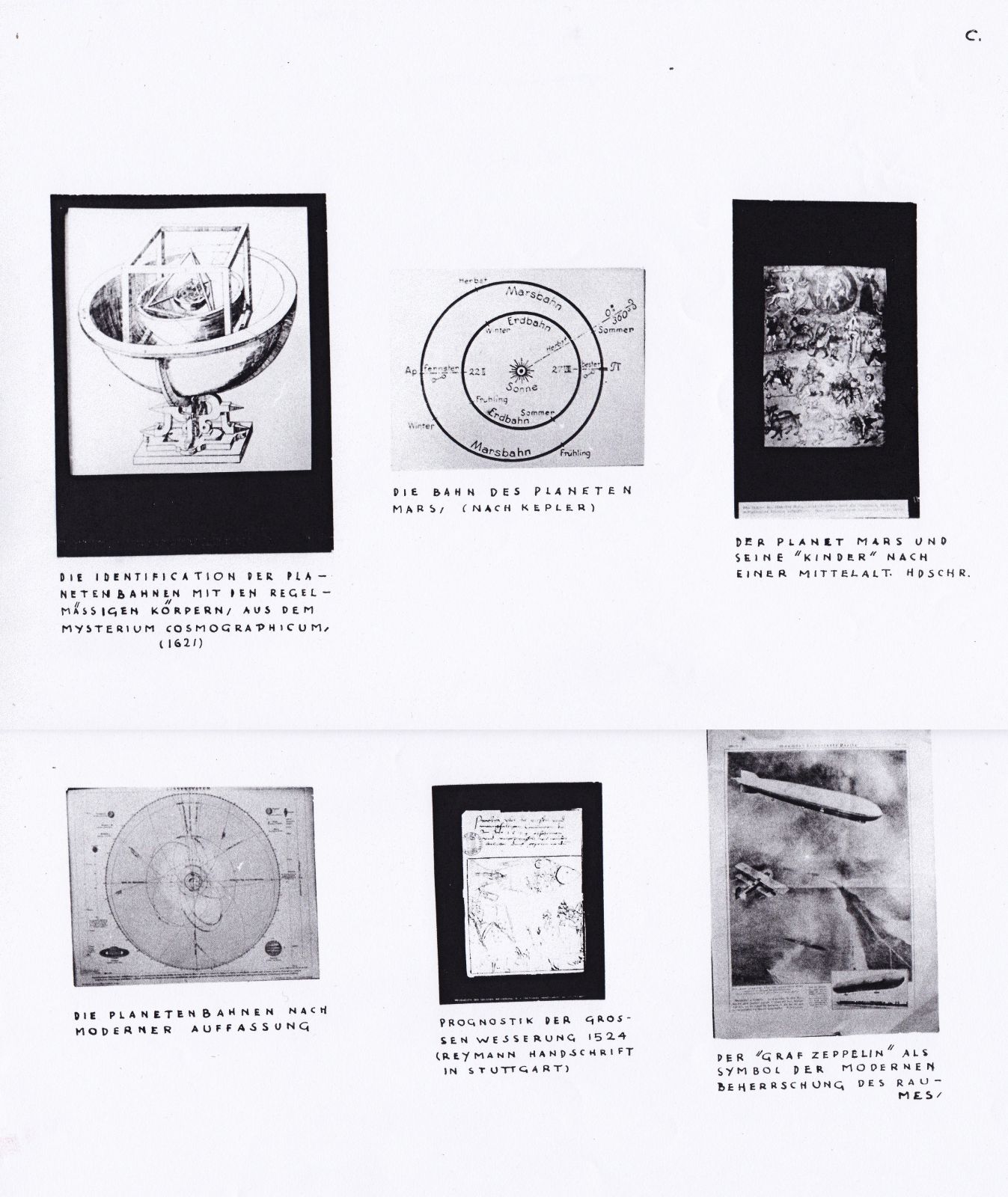
The intended fluid nature of the images that appear in Panel C is substantiated by Ernst Gombrich including Pisces from Leonhard Reymann’s Practica in the 1937 version of the Atlas (the Geburtsatlas). From other entries in Warburg’s diary it seems to be, in his own eyes, the true antagonist of Eckener’s Zeppelin.
In his ‘special’ (and rather partial) edition of the 1937 Atlas, Gombrich generally normalises, orders and explains the work in a condescending way that proves to be critical of the more adventurous associations made in the Atlas (on Gombrich’s failure to understand Warburg see, apart from Wind [1971] 1992, at least Agosti 1984, 442-444). In Panel C of the Geburtsatlas, Gombrich, under the six chosen images, writes the following captions (in sequence from the first top left):
1. Die Identification der Planetenbahnen mit den regelmässigen körpern/ aus dem Mysterium Cosmographicum (1621).
2. Die Bahn des Planeten Mars (nach Kepler).
3. Der Planet Mars und seine “Kinder” nach einer mittelal. Hdschr.
4. Die Planetenbahnen nach moderner Auffassung.
5. Prognostik der grossen Wesserung 1524 (Reymann Handschrift in Stuttgart).
6. Der “Graf Zeppelin” als Symbol der modernen Beherrschung des Raumes.
(Gombrich 1937).
That Gombrich decided to include the image of the menacing astral fish (that Warburg had used as an accompanying illustration for his 1929 essay Prophecy in the Age of Luther) is an indication that Warburg must have seriously considered the idea of evoking the phantasm of Reymann’s fish, so like the Zeppelin. In Gombrich’s preserved version of the Panel, however, the Zeppelin was interpreted as “the symbol of the modern conquest of space”, a definition that is laid aside in favour of the two additional meanings in the 1929 version of Panel C: the re-use of the Zeppelin in a positive key compared with how it was used in the First World War; dissemination of the news of the circumnavigation of the world in September 1929, by telegraph and then through the press (see, Panel C, the three details in sequence C.5, C.6, C.7). Substantially, Gombrich, in his reduced version of Panel C, by juxtaposing the threatening Fish of 1524 with the Zeppelin, records a phase in which Warburg, by morphological analogy, intended to highlight the twin forces of the astral demon promising disaster as well as being a symbol of the conquest of space – a phase that in 1929 Warburg had clearly overcome: the prodigious enterprises of the Zeppelin, converted from an aircraft designed for war, to an aircraft for exploration and tourism, viewed in the positive light of technology by Warburg, and supported by his decision to add to the Panel a series of images of the Zeppelin transmitted via telegraph and newsprint.
In the last months of Warburg’s life, the symbolic contrast between the two images – Reymann’s Pisces and Eckener’s Zeppelin – populated his imagination. On 21 September 1929, Warburg appears to have spoken to Edgar Wind and his wife:
Mit Winds (Frau Wind wohlgestellt zurück) über den Nachtrag zu Luther: Von Reymann bis Eckener Gesprochen (Warburg [1926-1929] 2001, 526).
The note “der Fisch!” seems to have been added later by Warburg himself. In a letter dated 24 September 1929 – a few days after Warburg’s note on the conversation with Mr and Mrs Wind was written – his wife, Mary Hertz, wrote to Aby that “from Teukros to Eckener, it will be one of the most exciting Panels [in the Atlas]”. In the same letter, Mary says she is amazed to have learned from Aby that studies for Mnemosyne would benefit from her remaining in Heligoland. The island of Heligoland had been one of Germany’s strategic outposts during First World War, and had been raided by Zeppelins (the first Zeppelin air disaster occurred in Heligoland on 9 September 1913); after the war, the island returned to being a tourist resort and it is likely that Aby spent a few days on vacation there.
A few days before this correspondence, on 8 September 1929, Warburg had suggested to Bing the title of a possible study:
“Die Ueberwindung der antiken Daemonfurcht in der Wetterkunde” oder “Von Ryemann [sic!] bis Eckener” (Warburg [1926-1927] 2001, 529).
This confirms once again that the introductory group of Panels was more than ever a work in progress, and the so-called “definitive version” of the Atlas is a photograph of one of the stages of an on-going exercise.
Many of the images arranged on the three surviving panels had already formed part of other montages and other combinations: in particular, the already cited commemoration of Franz Boll (1925); the exhibition which, in the end, never took place, on cosmology for the newly born Deutsches Museum in Munich (1917), of which a plan drawn by Bing, and photographs of various arranged Panels survive; finally, the exhibition on cosmology that should have inaugurated the Hamburg Planetarium (1930), finally implemented by Fritz Saxl, was also indebted to the work carried out for the Munich project, under various titles (Warburg [1926-1929] 200, 143-145).
Although the opening image on Panel A, for example, is a Dutch seventeenth-century engraving on copper belonging to Warburg himself, and later donated to the Planetarium, and already planned for a Panel for the exhibition planned in Munich (in Warburg [1917-1929], 2007), most of the images on Panel B had already been shown during the commemoration of Boll, on 25 April 1925 (Warburg [1925] 20143).
As for Panel C, during the same commemoration of Boll, there had been talk of the association of planetary orbits with regular bodies in Kepler’s Mysterium Cosmographicum (Warburg [1925] 2012, 381-385; Panel 50, 384), recalling the difficulties in calculating the orbit of Mars: hence, the illustrated Tübingen codex and the images of the scattered Children of Mars (Warburg [1925] 2012, 343 and Panel A) and the orbit of Mars according to the observations of Kepler, from Astronomia nova de motibus stellis Martiis (1609), the image from Mysterium cosmographicum (1621) and the more reassuring image of the planetary orbits according to modern concepts drawn from the Brockhaus Encyclopedia (1895) (on the genesis of the A, B, C, group of Panels, see De Laude 2015).
Appendix II. The Zeppelin airship: notes on the history of an iconographic adventure, from the First World War to Panel C of the Mnemosyne Atlas
Edited by Giulia Bordignon
Although used for a relatively brief period of time – the very early years of the twentieth century and the 1930s – the Zeppelin airships that scudded through the skies at the start of the last century were able to imprint themselves in the collective imagination becoming a veritable ‘fashion’: the elegant and at the same time imposing profile of these airships spread everywhere, from daily papers and newsprint, on various supports – from stamps to child games – becoming what today we would call a ‘pop image’. Only with the setting for the all-pervasive dissemination of this image can the significance of the inclusion of the three newspaper cuttings on Panel C of the Mnemosyne Atlas be fully appreciated. The events surrounding the making of the Zeppelin and its enterprises are summarised, below, together with its iconographic fortune.
From the beginning of the century, airships, with their majestic bulk, occupy the skies of the whole of Europe and the USA, alongside biplanes and hot-air balloons, and they are immediately identified as the most modern and ‘futureable’ means of controlling the sky. Count Ferdinand Graf von Zeppelin, an officer in the Württemberg army, was the inventor and promoter of the dirigible that took its name from him: the first model of the Zeppelin, called LZ1, flew for the first time on 2 July 1900, and remained airborne for 18 minutes.
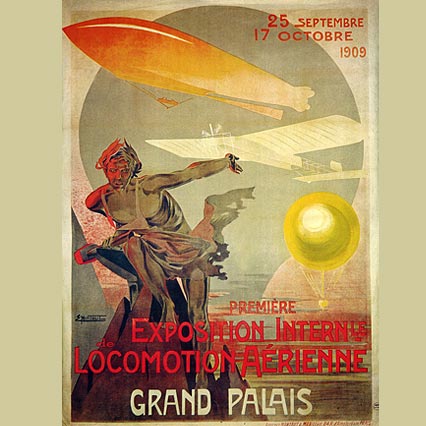
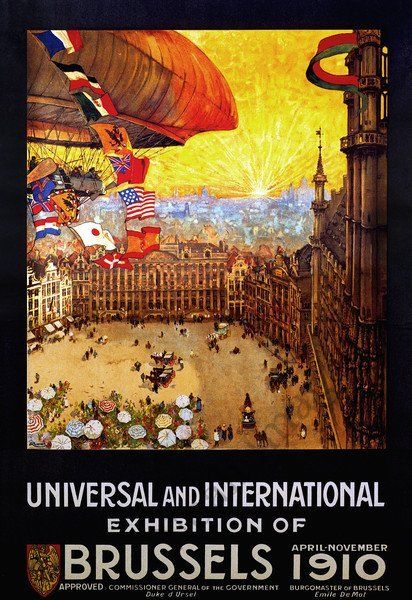
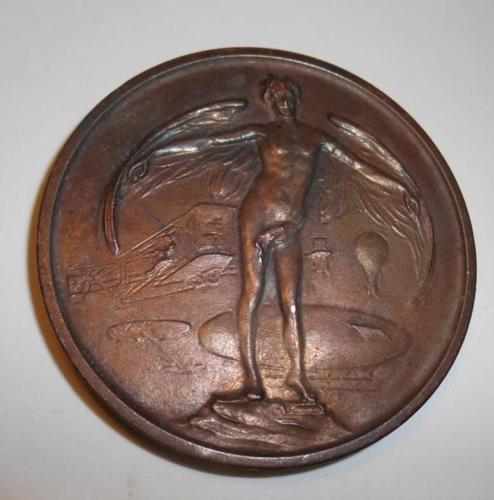
Poster of the first international aeronautical exhibition in Paris 1909: an ‘Haephestus-Prometheus’ points to an air-balloon, an airplane and a dirigible.
Poster of the international Expo in Brussels 1910: a dirigible decorated with flags flies over the city.
“Progress in aviation”: Icarus and new flying machines – from air balloons to dirigibles, medal coined by the Chicago Coin Company, 1910.
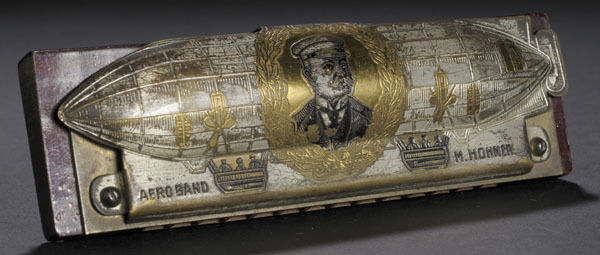
A mouth organ decorated with the silhouette of the Zeppelin and a portrait of Ferdinand von Zeppelin, ca. 1910.
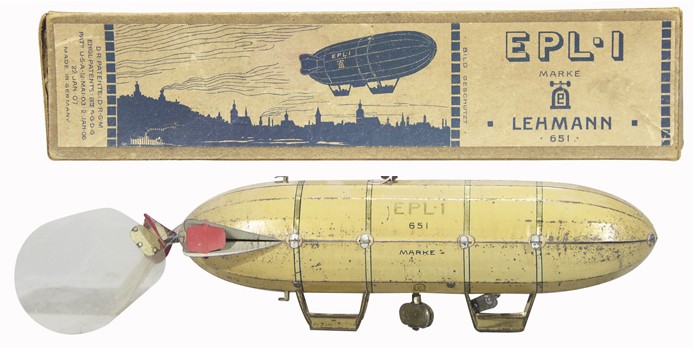

Toy dirigible made of tin, Germany, circa 1910.
“The Trial Trip. Leaving horse, drum, and ball, See if this will fly at all”, postcard, ca. 1910.
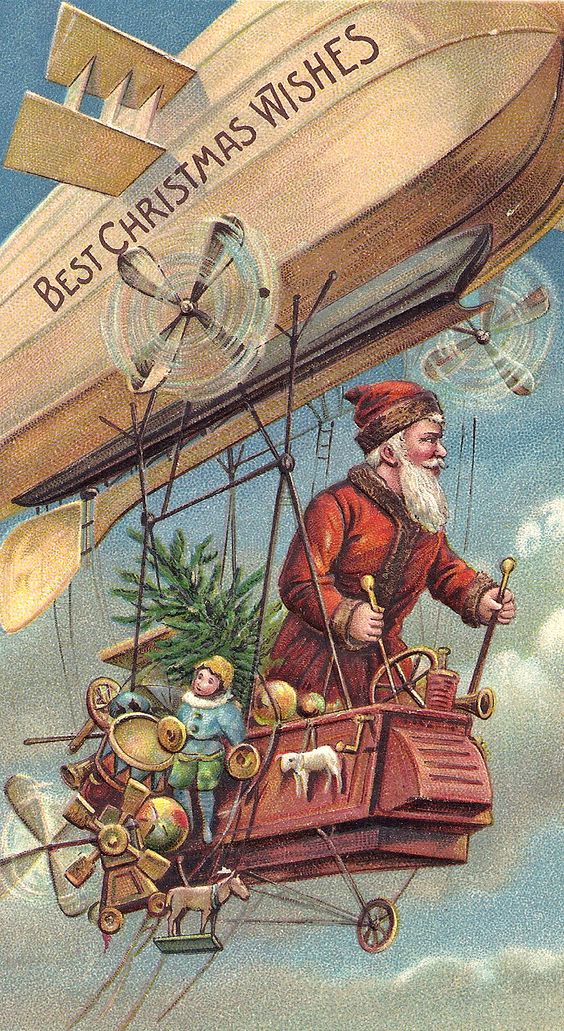
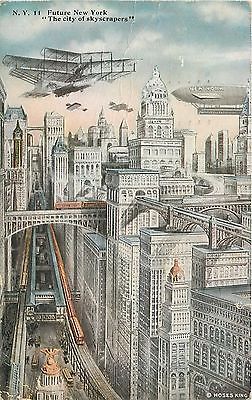
Santa Claus delivers his gifts by dirigible, postcard, 1910 circa.
“Future New York. The city of sky scrapers”: in the skies of this ‘Metropolis’, various airplanes are in flight including a dirigible, American postcard. 1919.
With the outbreak of the First World War in 1914, Zeppelin produced 21 dirigibles to be used for military purposes. Compared with other flying machines – also recently brought into use – dirigibles had the advantage of being able to transport heavier loads of munitions and explosives. The first images of dirigible bombers appear in photos in chronicles and in wartime postcards: in England, the “Midnight killer” caused over 2,500 deaths. As can be seen in a light-hearted printed image, the Zeppelin was used widely for night-time reconnaissance making it necessary to be suitably and elegantly attired even at night.
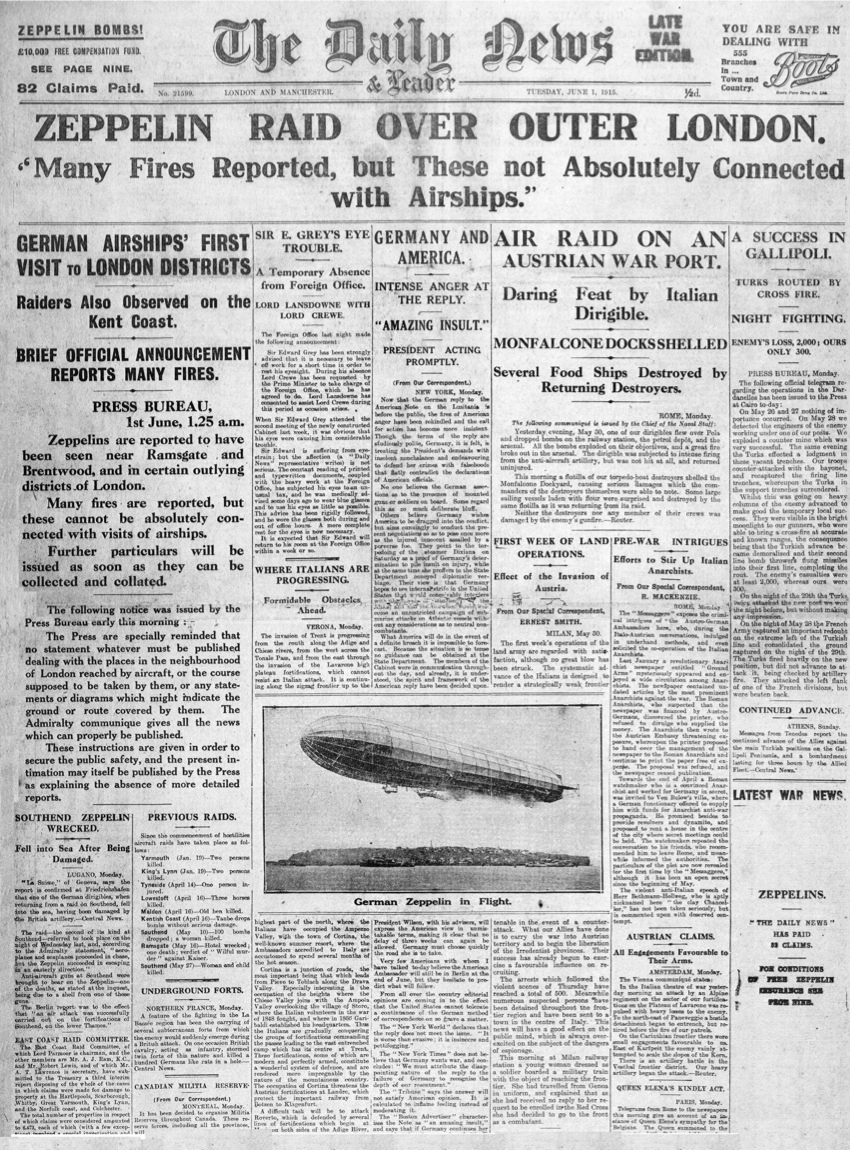
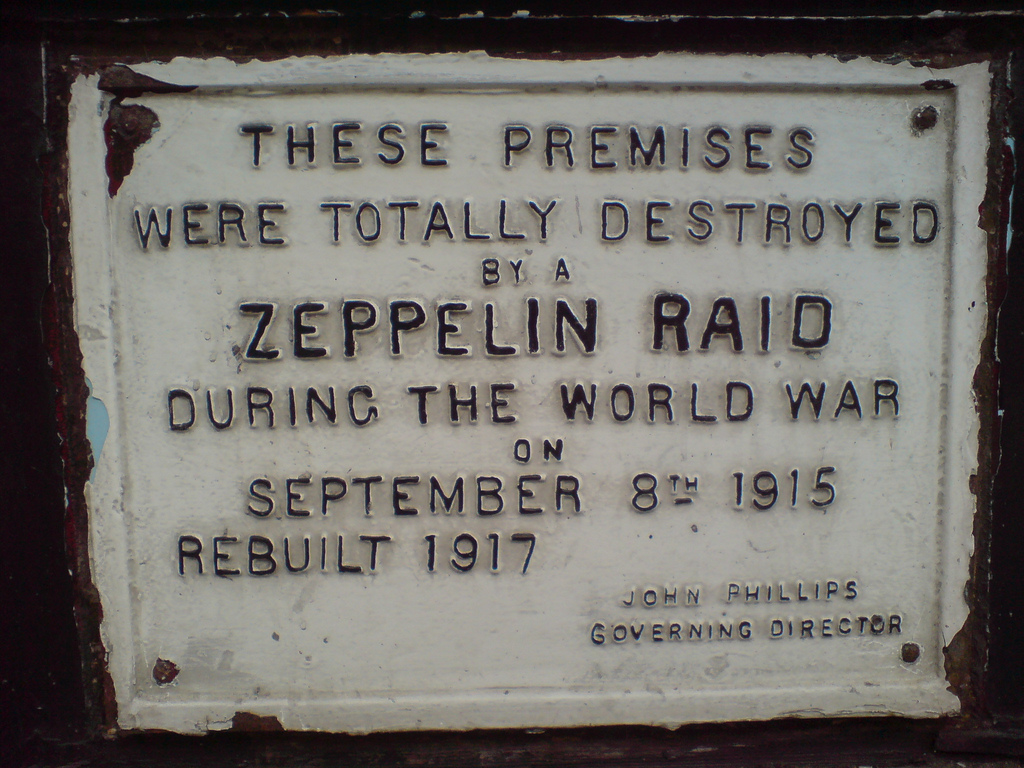
First page of the “Daily News”, 1 June 1915: “Zeppelin raid over outer London”.
Plaque commemorating the destruction of a building caused by a Zeppelin raid on London, 1915.
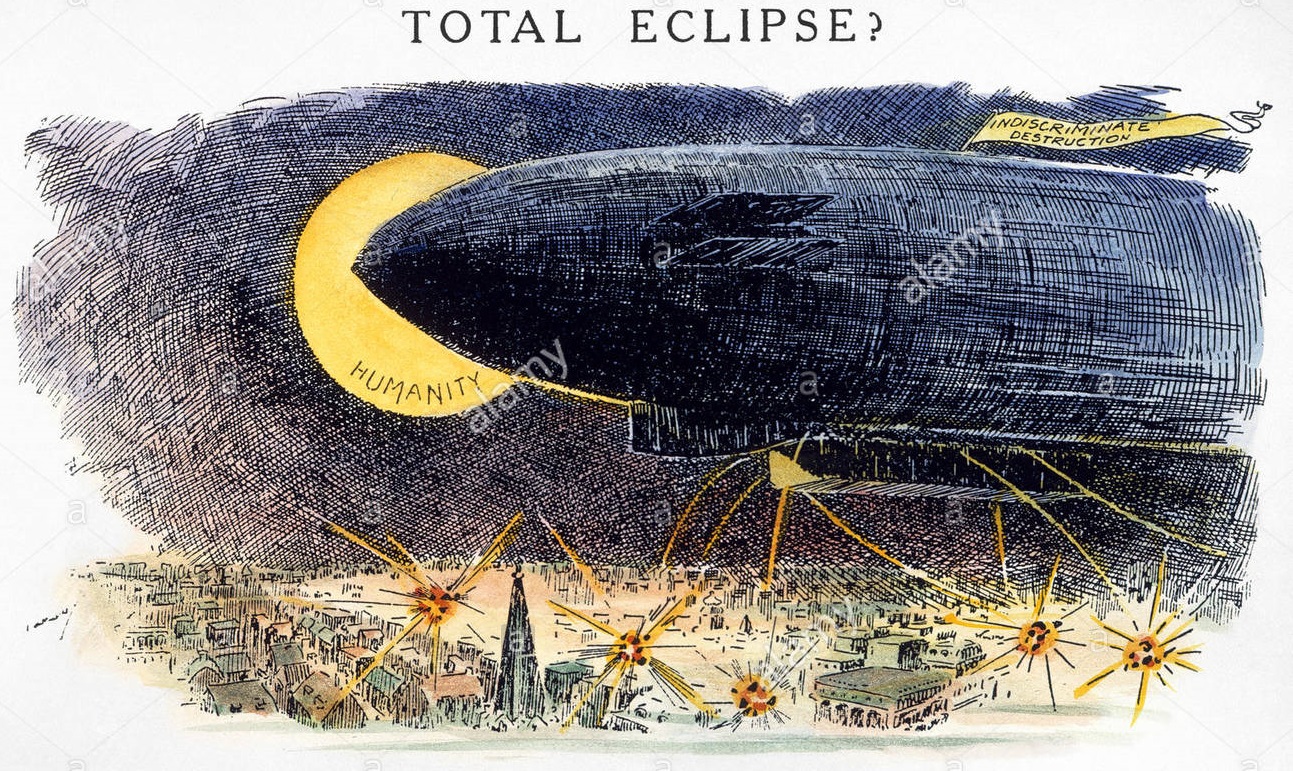
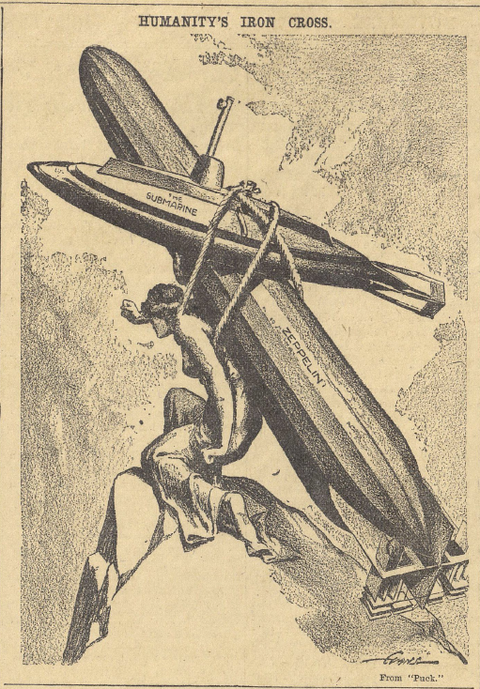
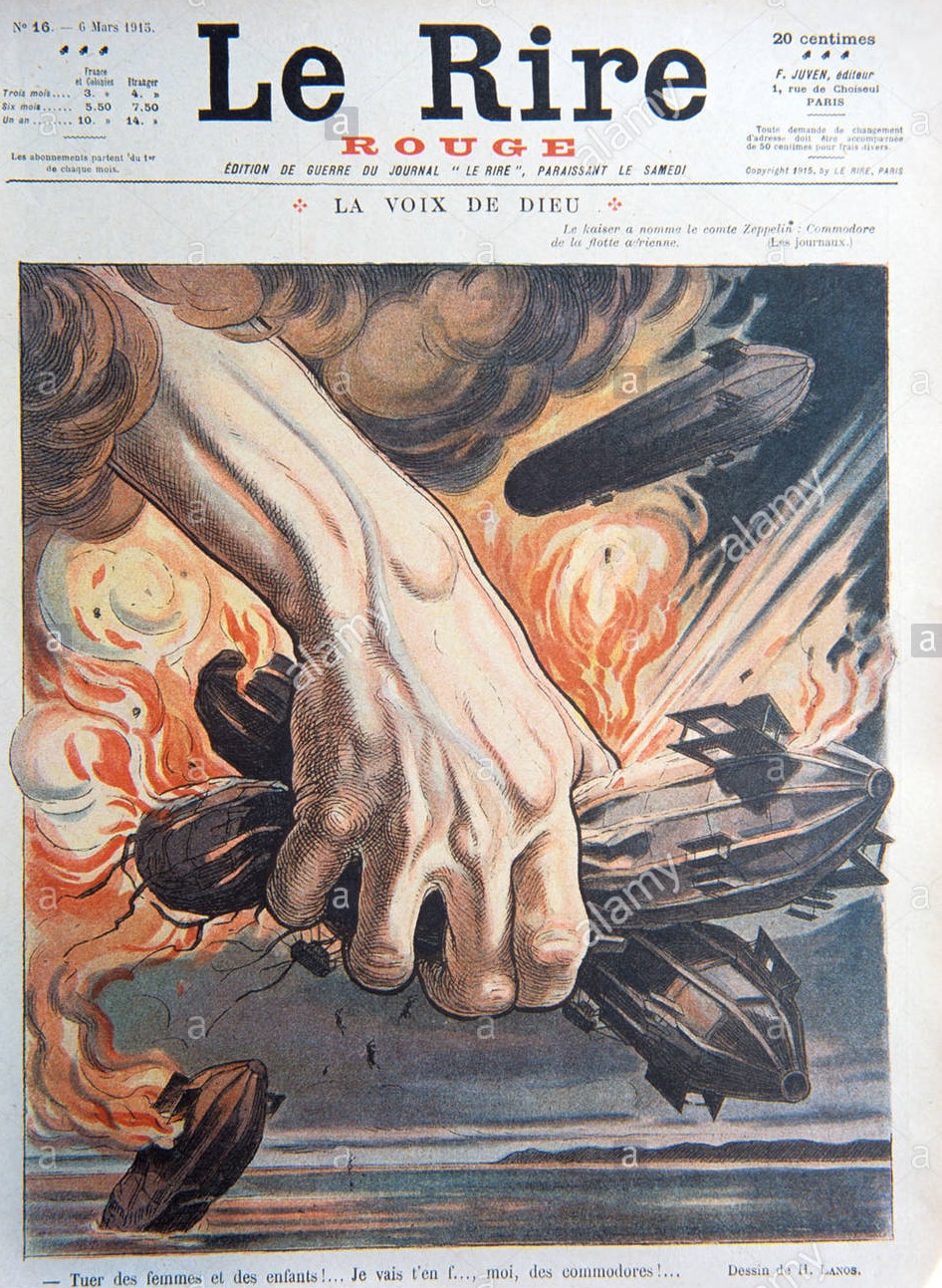
“Total eclipse?”, British First World War postcard: a Zeppelin carries the flag of “indiscriminate destruction” over the rooftops of London and obscures “humanity”.
“Humanity's iron cross” formed by a dirigible and a submarine, British illustration of the First World War.
“The voice of God”, cover of the French newspaper “Le Rire”, March 1915.
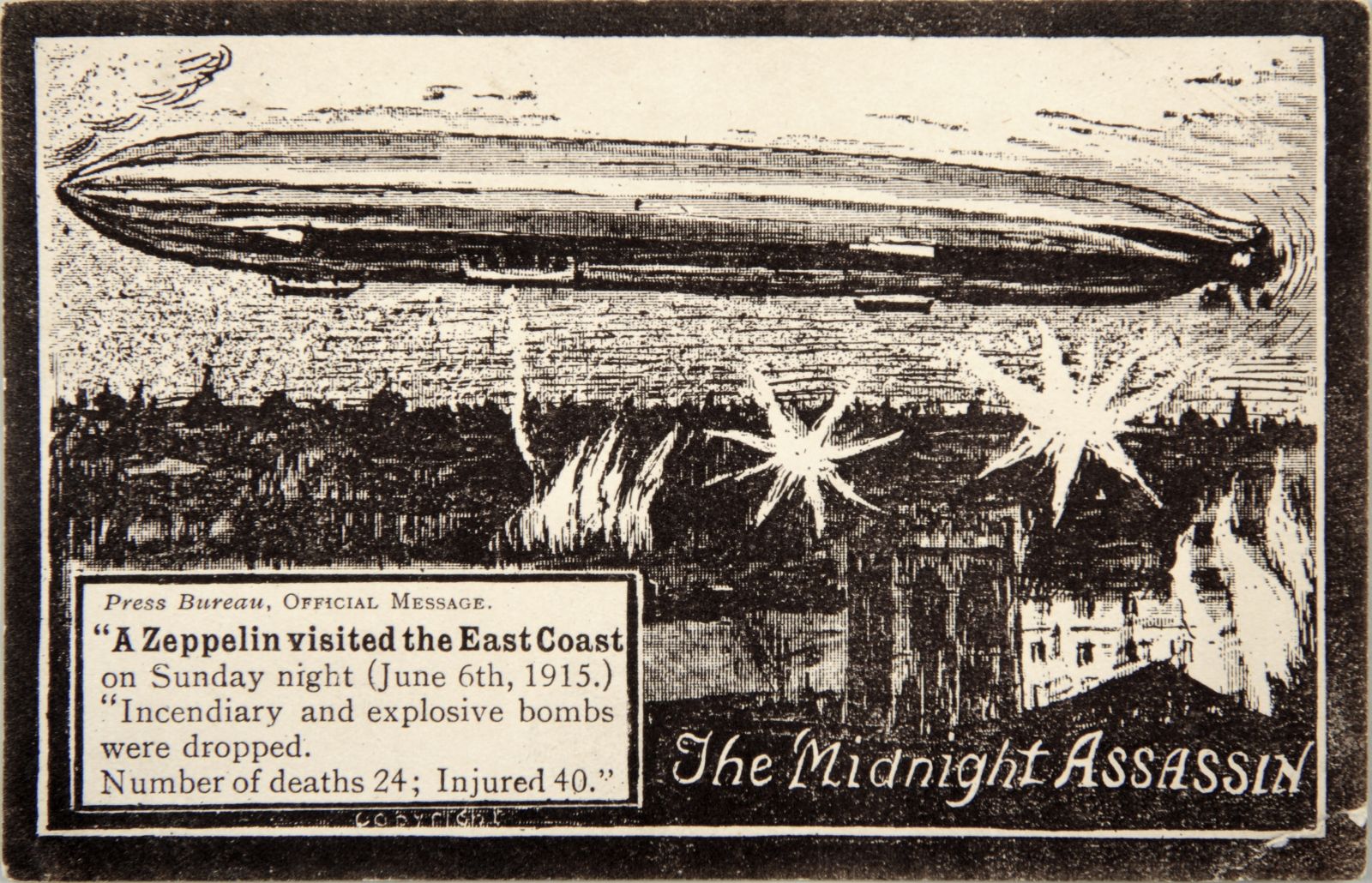
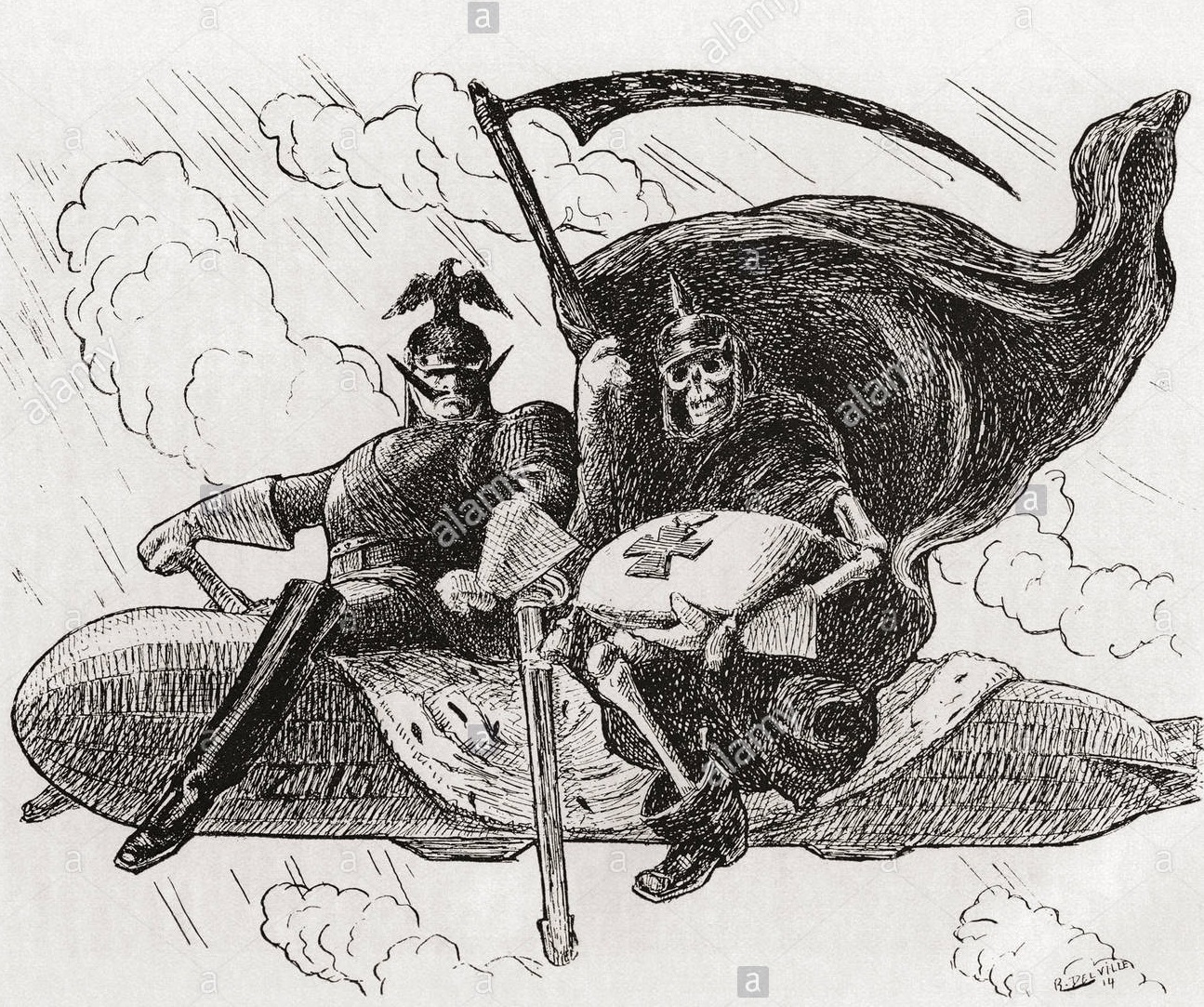
“The Midnight Assassin”, British postcard, 1915, bearing the number of victims and wounded as a result of a raid on the east coast.
Commander of the German army and personification of Death riding a Zeppelin, British First World War postcard.
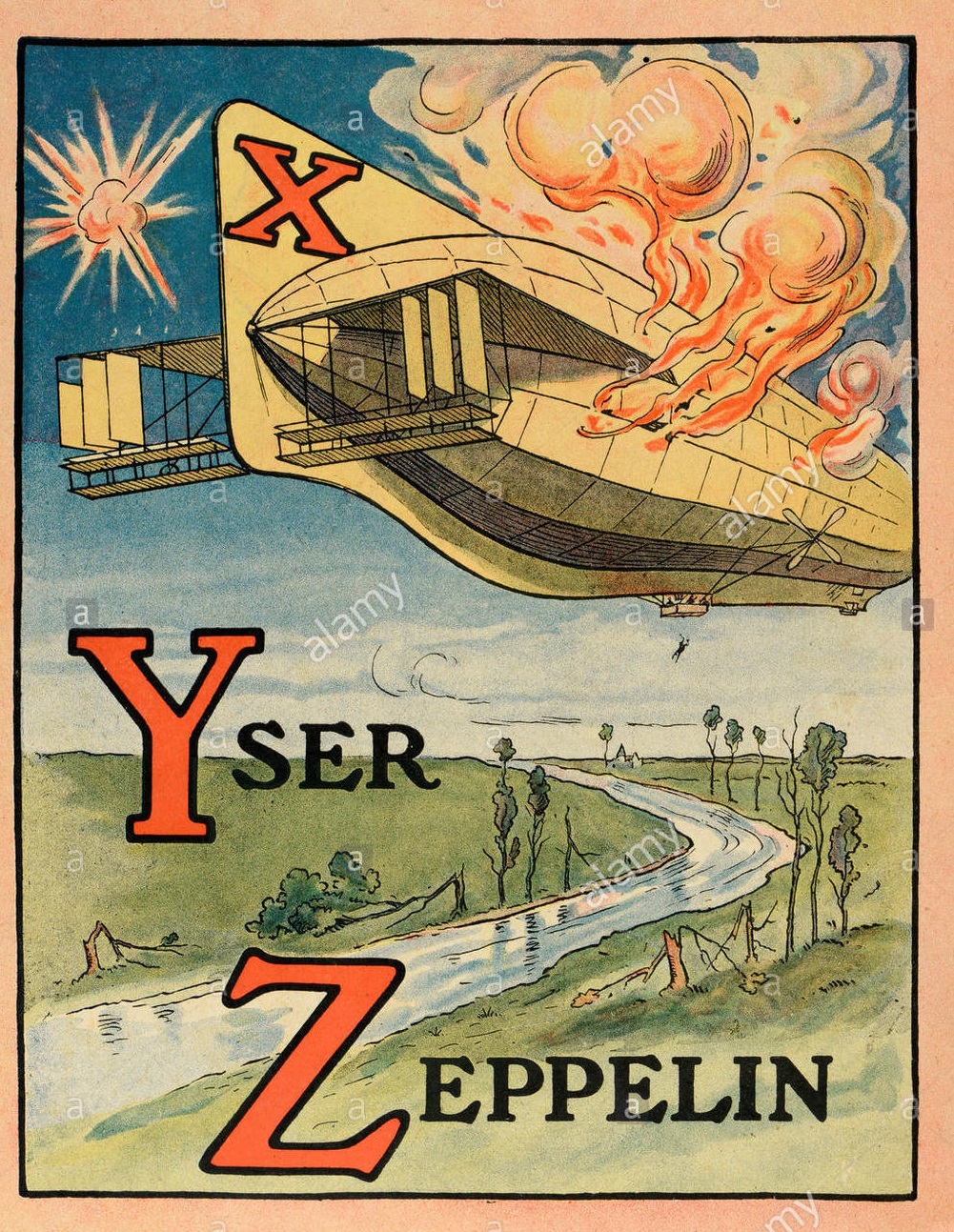
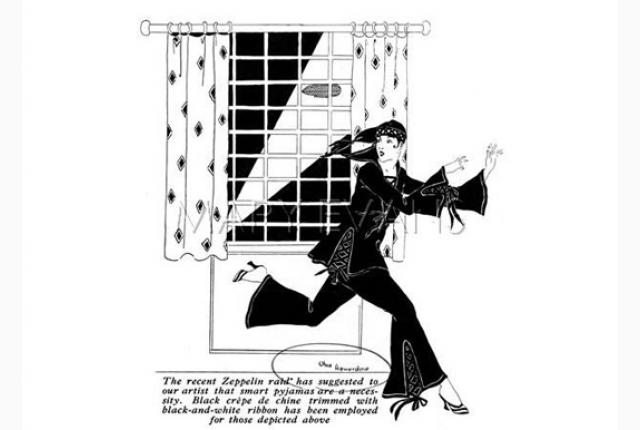
“Y for Yser, Z for Zeppelin”, illustration from Alphabet de la guerre by Henri Lanos, 1918.
“The recent Zeppelin raid has suggested to our artist that smart pyjamas are a necessity”: British illustration of the First World War.
At the same time, even in nationalist German propaganda, the image of the Zeppelin is disseminated via various iconographic ‘vehicles’: stamps, postcards, and in the form of theatrical costume.
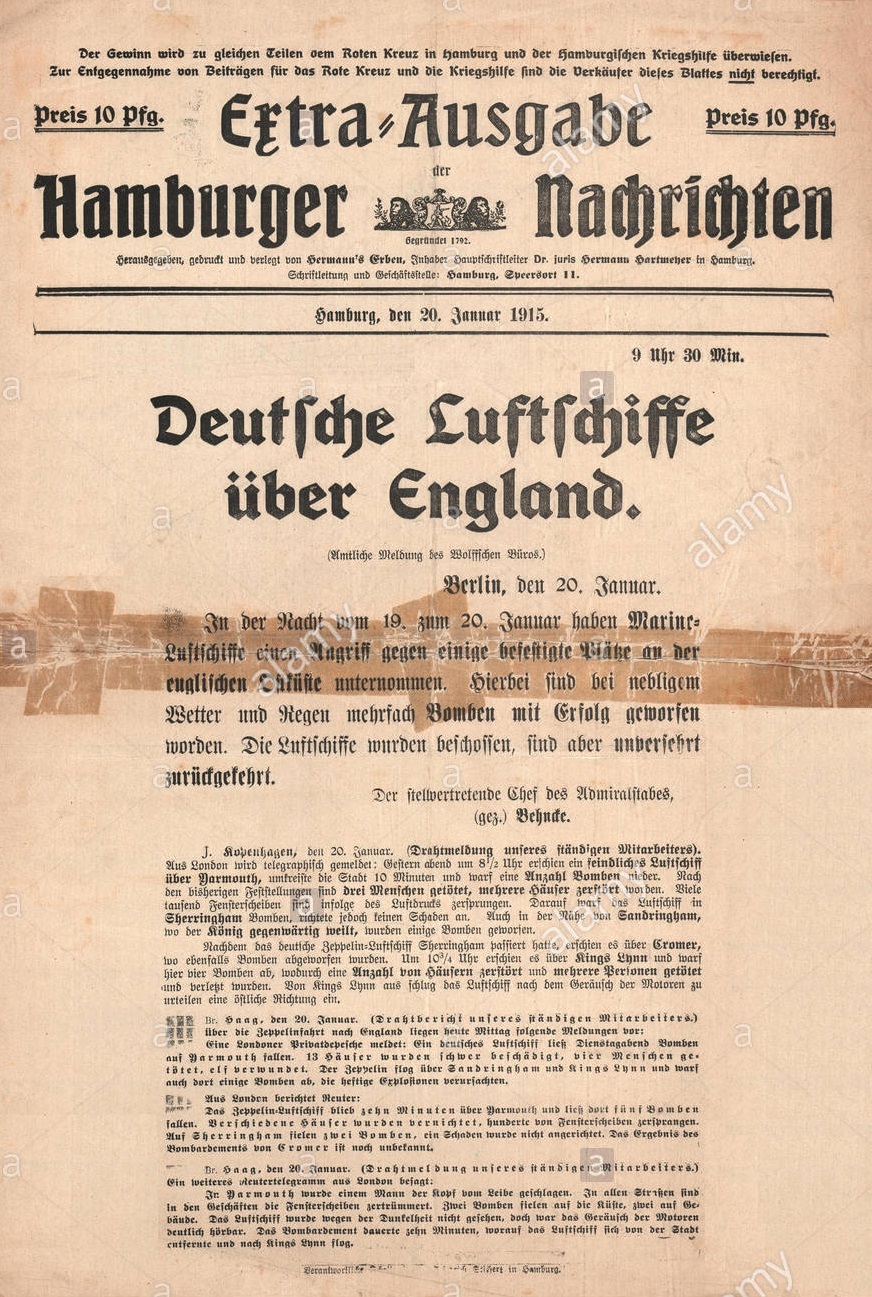
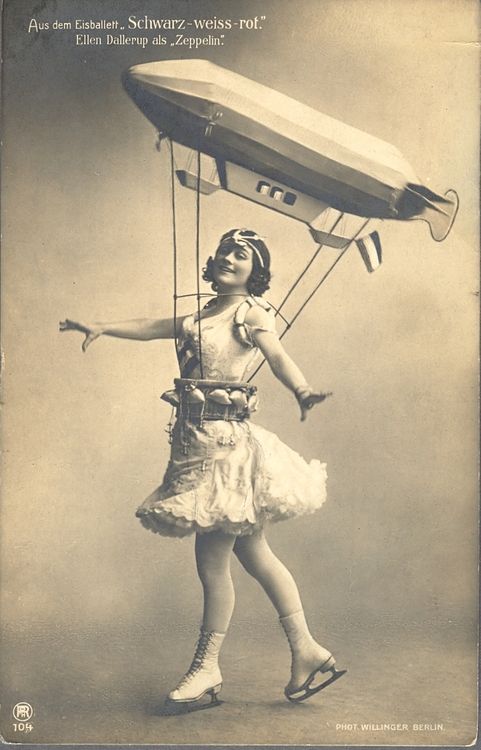
Front page of the “Hamburger Nachtrichten”, 20 January 1915: “German dirigibles over England”.
“From the ballet on ice Black-White-Red. Ellen Dallerup as the Zeppelin”, German poster, ca. 1910.
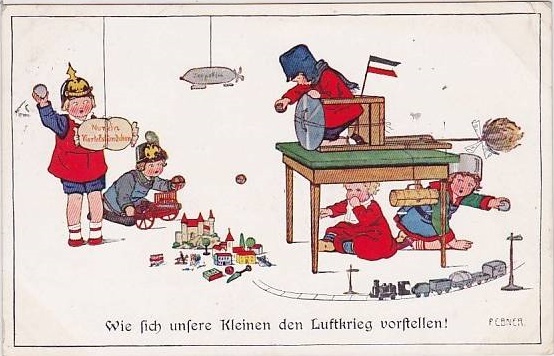
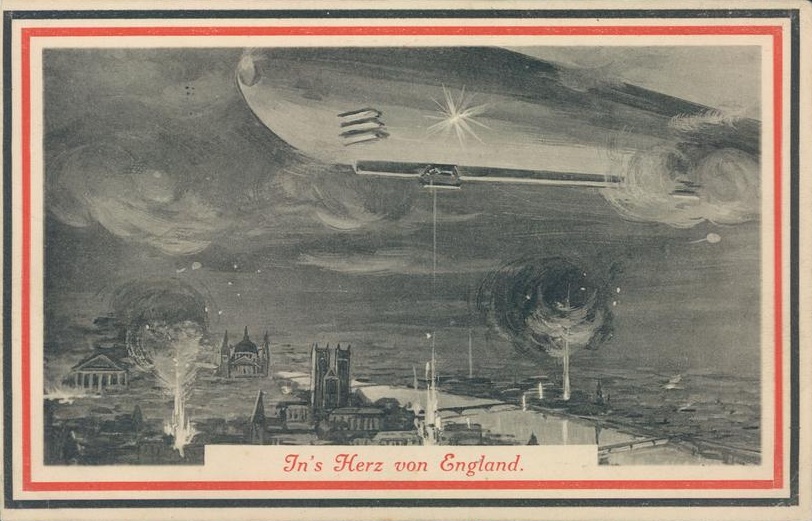
“How our little ones act out the air war”, German First World War postcard.
“In the heart of England”, German First World War postcard.
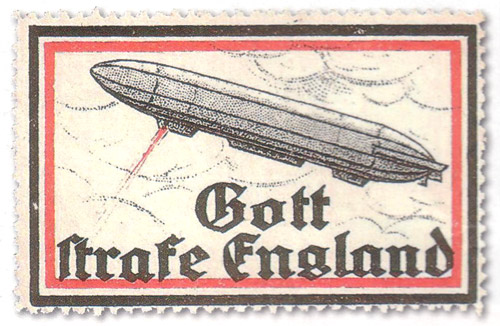
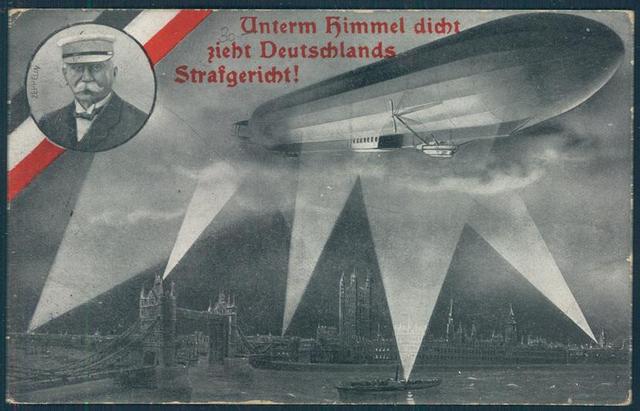
“God punishes England”, German propaganda stamp.
“Germany’s punishment comes through your skies”, German First World War postcard.
However, as a means of military transport, Zeppelins had a great disadvantage: despite their gargantuan structure, they were fragile and full of hydrogen, they were highly inflammable, and could be easily shot down by antiaircraft. Very early on, the British press portrayed the inefficiency of the wartime dirigibles in cartoons.
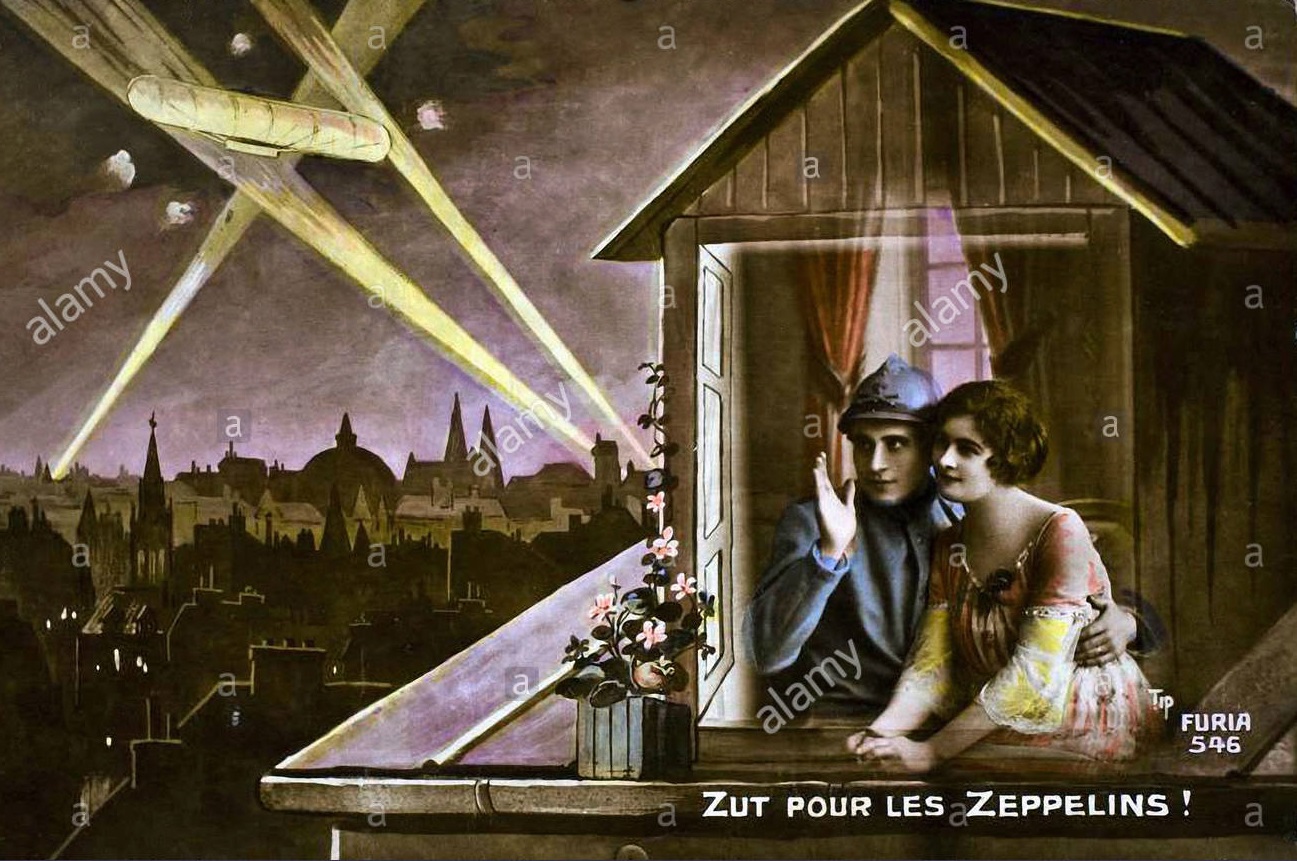

“Damn the Zeppelins!”, French First World War postcard.
“You scared me: I thought you were a Zeppelin”, British First World War postcard.
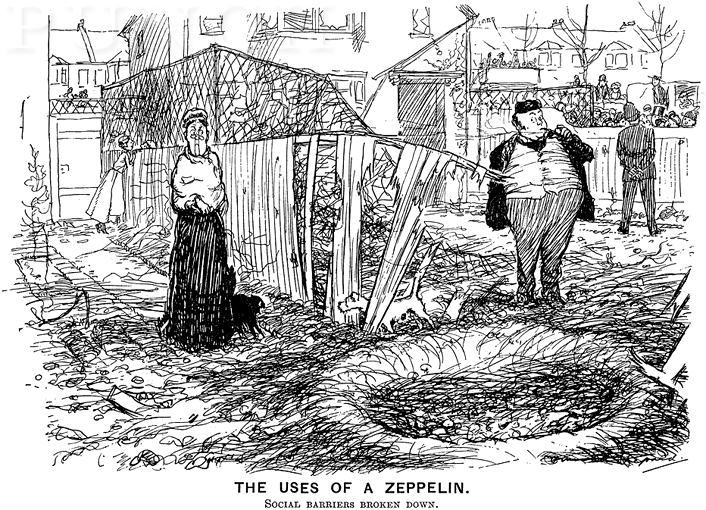
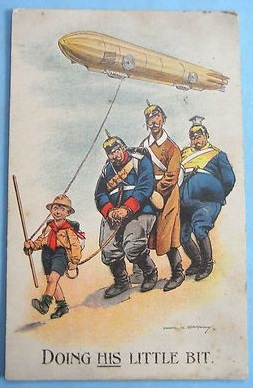
“The uses of a Zeppelin. Social barriers broken down”, British First World War cartoon.
“Doing his little bit”, British First World War postcard.
After the war, the Treaty of Versailles barred Germany from maintaining a military air force, but Zeppelins would continue to be built for transporting passengers and mail. Hugo Eckener, a military pilot from Flensburg and a colleague of count Zeppelin (who died in 1917), was in fact determined to continue to build dirigibles as a business, and succeeded in convincing the U.S.A. and the German government to allow his company to build the Zeppelin LZ126 (later renamed USS Los Angeles ZR-3), for the United States Navy as part of war reparations imposed on Germany. Eckener launched a campaign to raise the necessary funds to build the new dirigibles when the Weimar Republic refused to support the scheme. The German people responded enthusiastically. Sponsorship of the enterprise proved to be highly successful also thanks to Eckener’s abilities as a publicist and his aptitude for public relations, and included postcards, brooches, medals, and stamps – memorabilia produced as visual evidence of support for the ‘reborn’ Zeppelins.
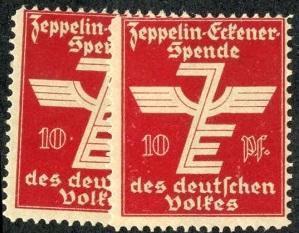
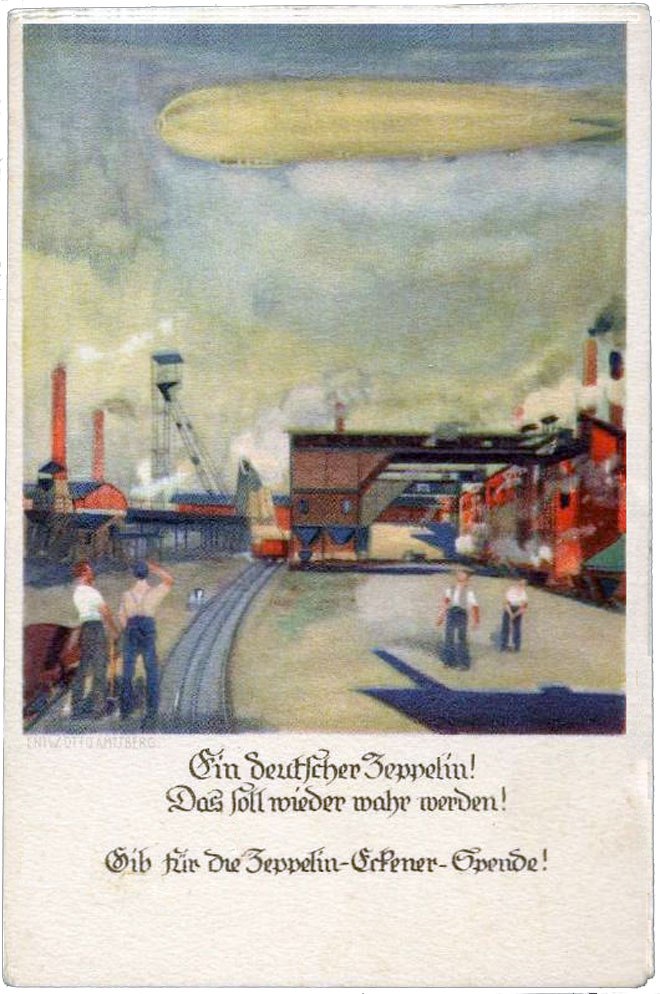
Donation stamps in support of the Zeppelin-Eckener Fund.
“A German Zeppelin! It will be a reality once again! Support the Zeppelin-Eckener Fund!”: postcard for the Zeppelin-Eckener Fund.
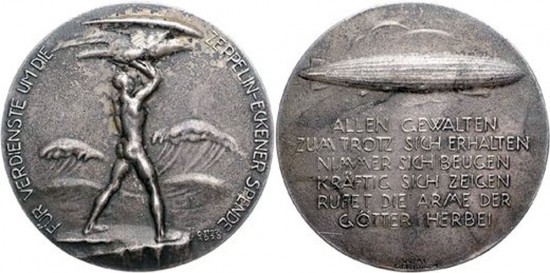
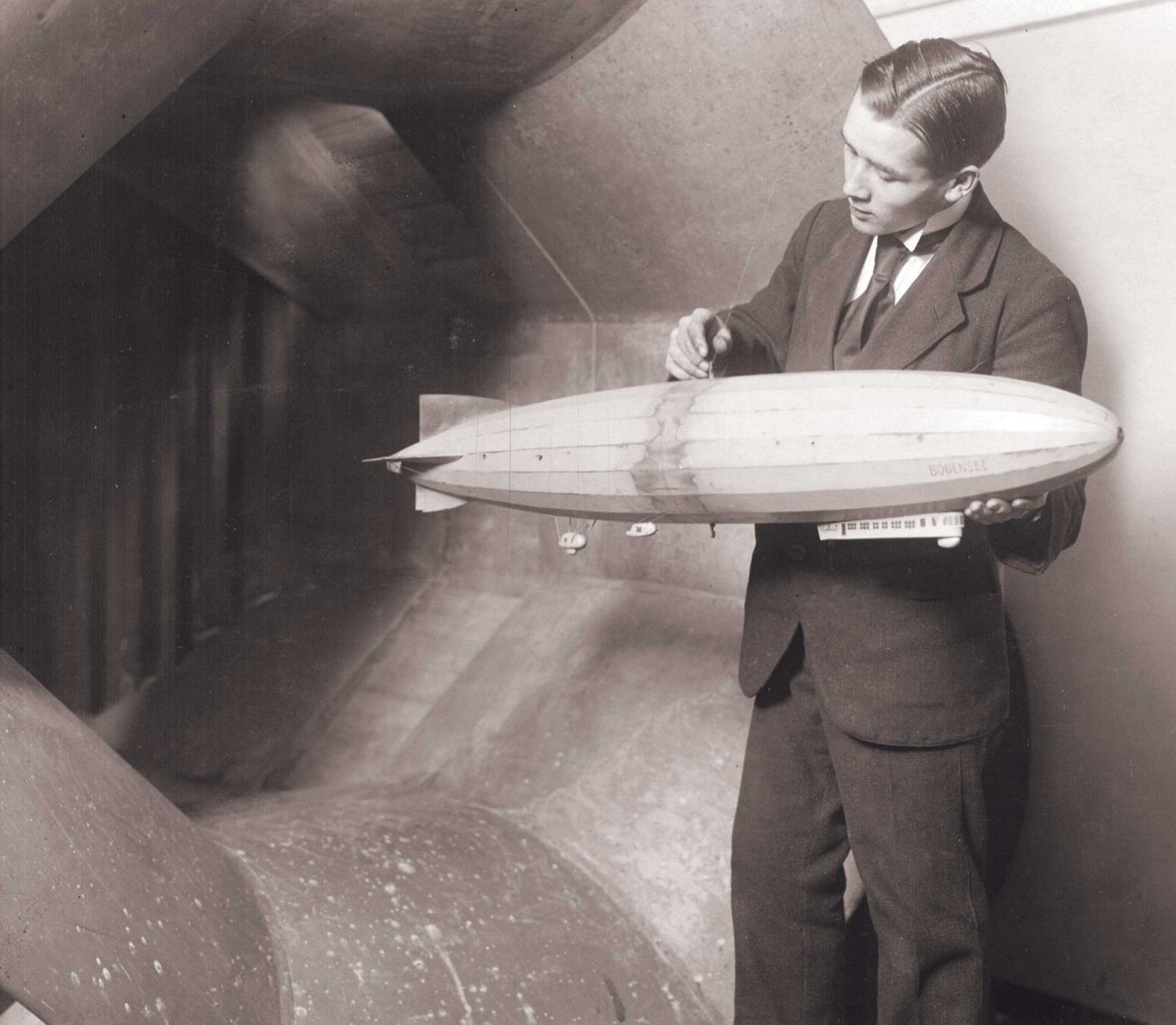
“Resist with all your might, never give in, look strong, invoke the arms of the gods”: medal, with verses by Goethe in support of the Zeppelin-Eckener Fund.
Model being tested in a wind tunnel for the first civilian flight of the Zeppelin, 1919.
Eckener himself captained the first non-stop flight between Europe and America: the transatlantic flight started on 12 October 1924 in Friedrichshafen, on Lake Constance, and arrived in Lakehurst, New Jersey, three days later. The journey was an international success, and, according to Warburg’s letters that can be consulted on the database of the Warburg Institute Archive, Eckener and his air enterprises were from this date onwards a topic of particular interest to the scholar: in 1924, in fact, Warburg asked his brother Max to send him materials on the Zeppelin (asking him to confirm the news that the first package delivered by Eckener in America was a box of toys). He also sent Eckener his essay Airship and Submarine in the Medieval Imagination, and invited him to discuss with him the gradual popularity of air travel (letter to Felix Warburg, 5 November 1924: WIA GC/16960; letter to Arndt von Holtzendorff, 14 December 1924: WIA GC/14746). Like the mythical adventure of Alexander the Great, examined by Warburg in his essay, Eckener’s too, despite “its plethora of marvels [...] has a rationalistic side”: the transatlantic flight, covered by the media in tones of wonder, was accomplished thanks to the extraordinary skill of the captain, but also to technological progress. Moreover, in his 1929 notes, Warburg juxtaposed Charles the Bold – who commissioned the tapestries portraying the enterprises of Alexander the Great – with “Hugo [Eckener] the Cautious” (from his Roman Diary, 17 September 1929; Warburg [1926-1929] 2001, 529).
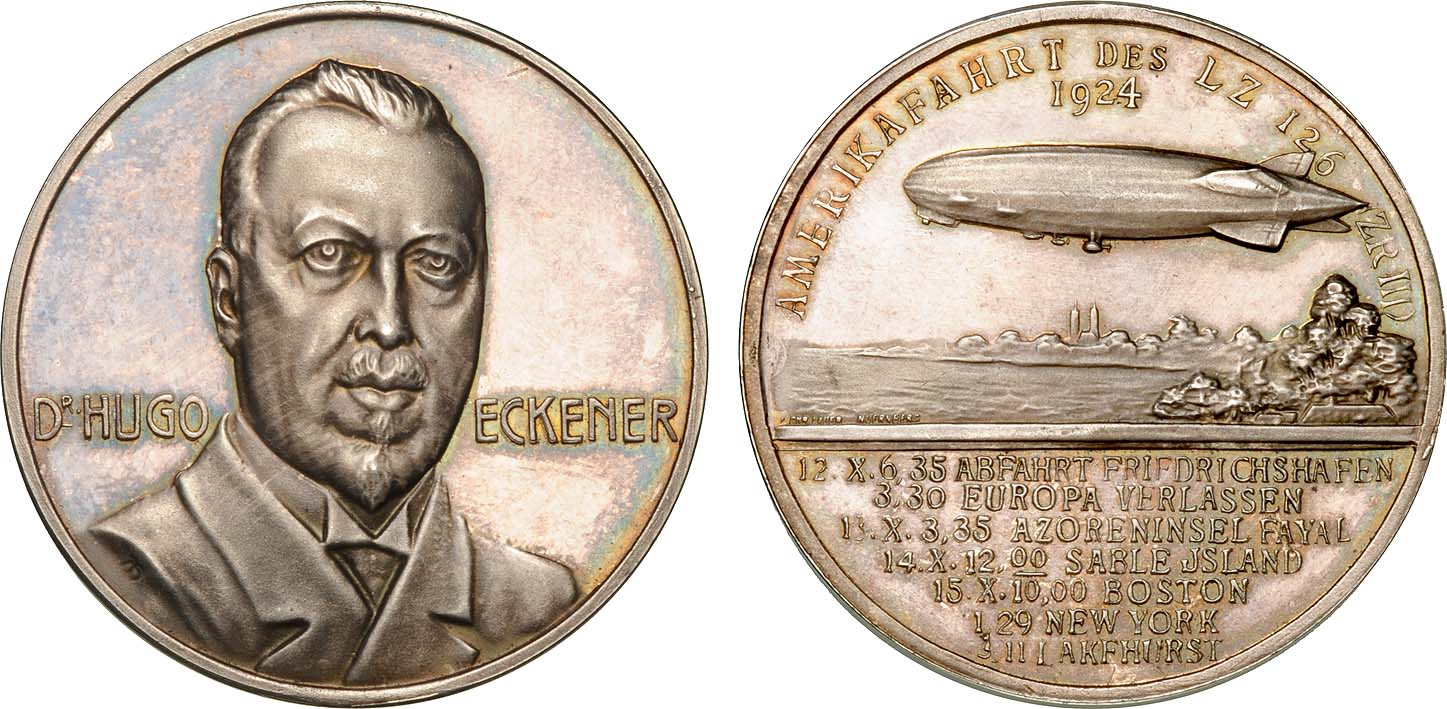
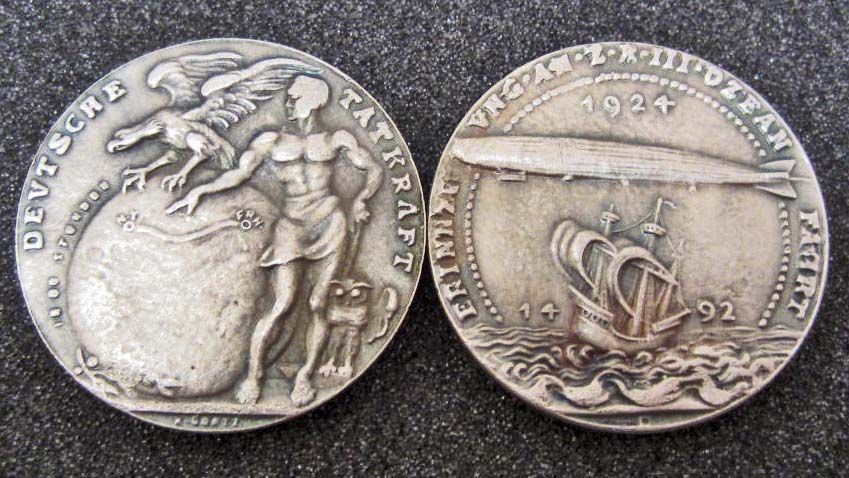
Commemorative medal of the Zeppelin’s Amerikafahrt in 1924: on the recto, a portrait of Hugo Eckener; on the verso, the chief dates and times of the enterprise begun on 12 October, the day America was discovered.
Commemorative medal of the Zeppelin’s Amerikafahrt in 1924: on the recto “German might” is portrayed by a character in the posture of a hero, accompanied by an eagle and a owl indicating the route taken by the Zeppelin around the world; on the verso, the dirigible, with the date 1924, is portrayed flying over a caravelle in full sail, accompanied by the date 1492.
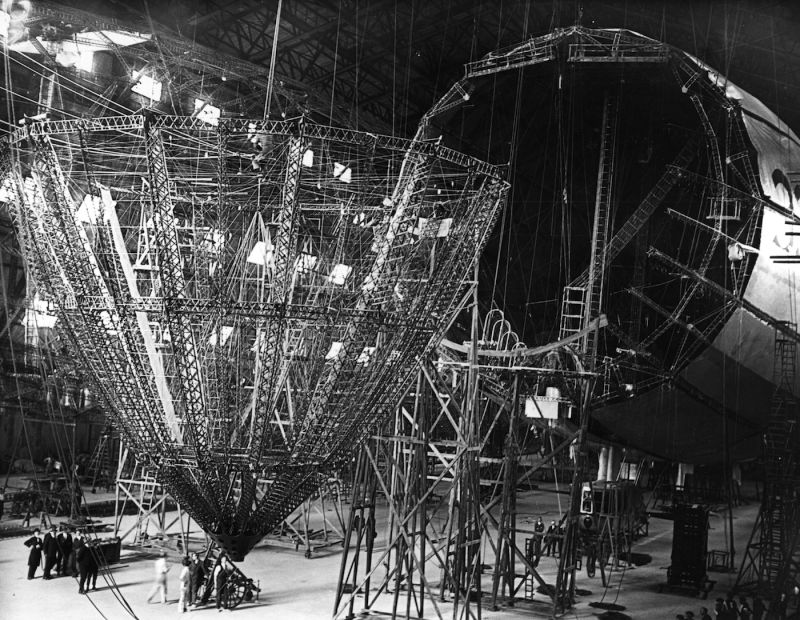
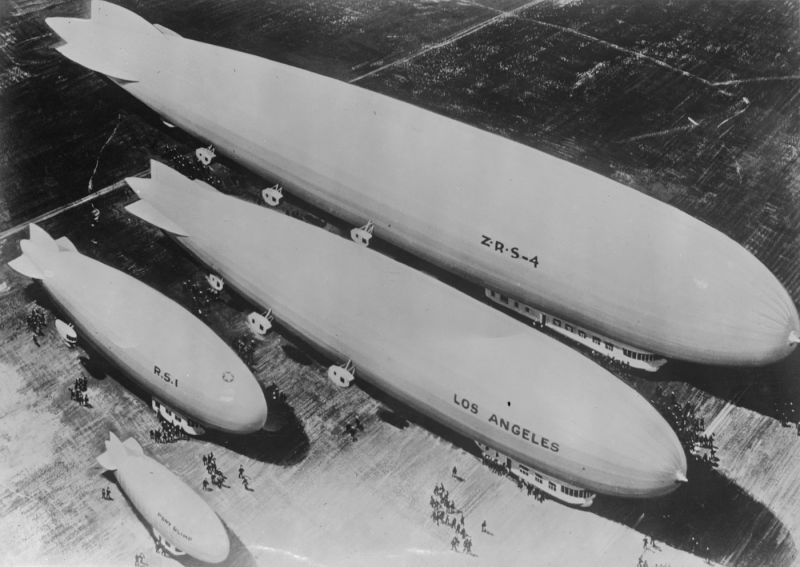
The Zeppelin model R33 being built in 1925.
Various models of the Zeppelin waiting for passengers to board, USA 1925.
Warburg’s interest in the Zeppelin continued in the years that followed; between July and August 1925, Aby wrote to the publisher Teubner, proposing a publication on the Zeppelin’s Amerikafahrt and defining Eckener’s undertaking as “a revolutionary development in humanity’s approach to the cosmos”, (letters to Alfred Giesecke dated 31 July 1925 and 19 August 1925: WIA GC/16904, WIA GC/16916). In October 1925, Warburg and Eckener met, at last, in the KBW headquarters (letter from Mary Warburg to Marietta Warburg, 13 October 1925; WIA GC/34111): a letter from Max Warburg (to Aby Warburg 19 March 1920: WIA GC/24895) shows that Eckener was excited about his conversation with Warburg, who in his second letter to Giesecke mentioned earlier, had supported the need for “a Boys Own for adults on the history of German aviation”.
In the same year, Warburg supported a Zeppelin journey to explore the North Pole, which finally took place only in 1931 (the enterprise was preceded in 1926 by the journey taken by the Italian airship, Norge, captained by Umberto Nobile with Roald Amundsen). On this occasion, writing to Felix von Eckardt, Warburg emphasised optimistically that “airspace has to be international, a nationalistic interpretation no longer works” (letters to Felix von Eckardt, 2 September 1925 and 10 September 1925: WIA GC/15826 WIA GC/15827). So it was that, with Eckener’s shrewd ‘promotional’ activities, the Zeppelin, the monstrous child of the First World War, was converted to an instrument of knowledge and peaceful connection (a film recording a flight of the Zeppelin over London in 1931 bears the title “This time without any bombs”).
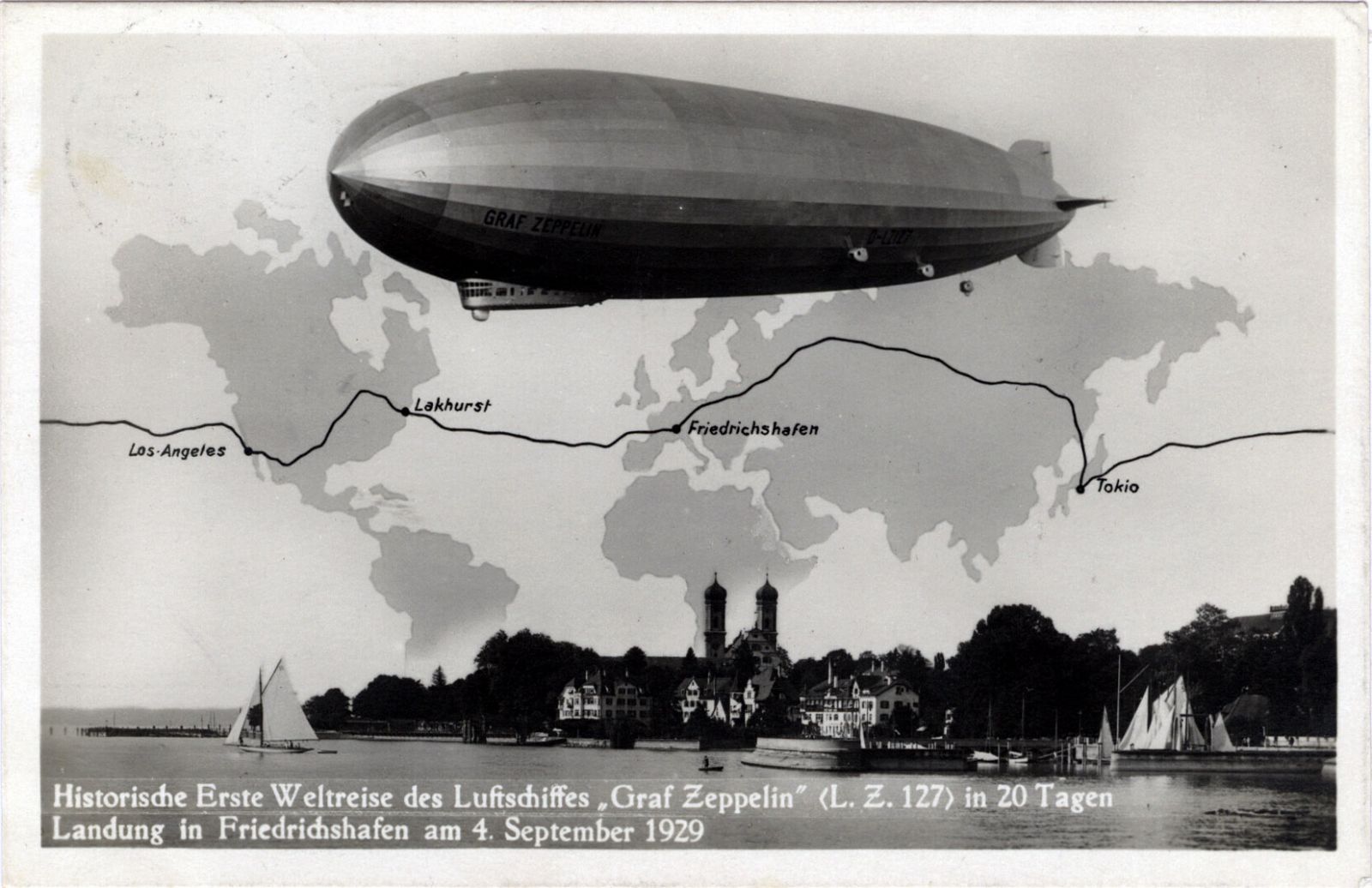

Commemorative postcard of the Zeppelin’s Weltreise in 1929, with the Wandercarte of the route.
Passenger compartments in the Zeppelin during the circumnavigation of the world in 1929.
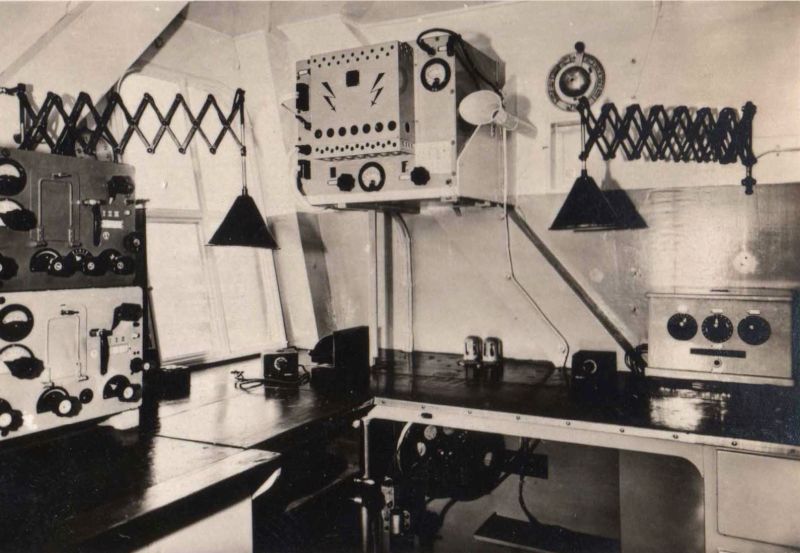
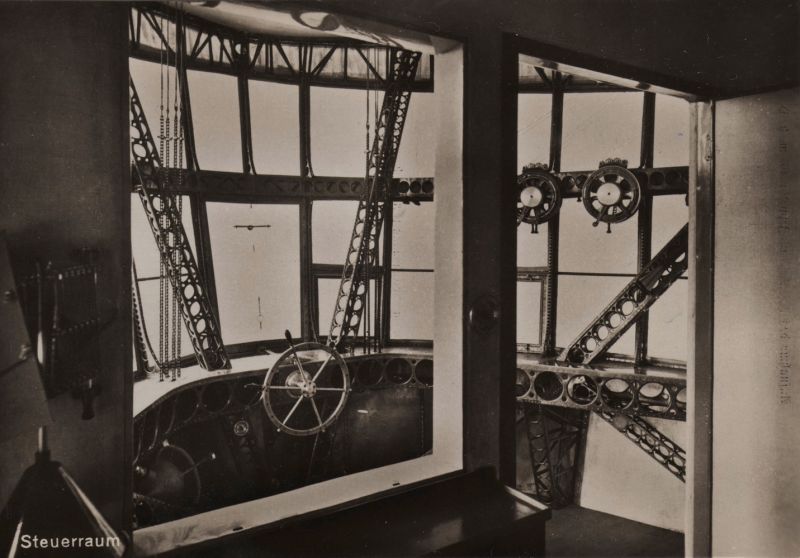
The Graf Zeppelin’s on-board flight instruments, ca. 1929.
The Graf Zeppelin’s flight deck and rudder, ca. 1929
In 1929, almost a seal of this conversion – in Warburg’s terms, we could perhaps describe it as an “energy reversal” of the valence of the image – Eckener carried out his circumnavigation of the world – the only one by that time performed by a dirigible, and only the second by an aircraft. During the flight, there was an accident that was widely broadcast in the media: the dirigible was seriously damaged in a storm off Bermuda that ripped off the material from one of its fins-rudder. The airship survived only as a result of Eckener’s expert manoeuvres and the bravery of the crew including the captain’s son who, during the flight climbed onto the fin, repaired the damage, and patched the fabric using covers and materials from on board the vessel, remaining suspended a few meters above the stormy sea. In Warburg’s own notes, 1929, which describe the “overcoming of the ancient fear of demons on meteorological maps”, we read not so much of his personal admiration for the airship’s captain, as his identifying him as an emblematic figure of the laborious spiritual evolution of man:
From Reymann to Eckener, that is to say, from Sphaera Barbarica to meteorological maps, we can metaphorically describe that climb to Calvary as “cosmic orientation”.
from Roman Diary, 18 and 19 September 1929 (Warburg [1926-1929] 2001, 530).
It is as though the contemporary Eckener embodies and brings about the figural transliteration that – from astrological demons going back to Babylonian times together with the allegorical personification of Fortuna coined in the Renaissance – led humanity to unchain itself, at least tentatively, from the forces of fate through the logical and rational representation of natural powers.

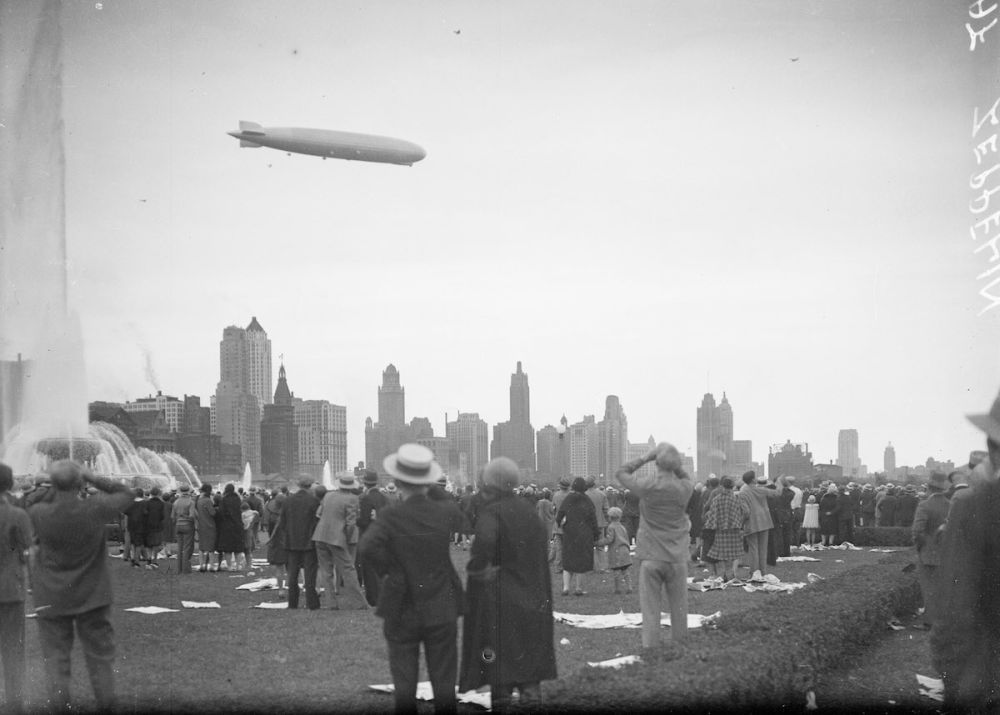
Front pages of the “New York-American”, covering the various stages of the Zeppelin’s round the world journey in 1929.
People gathering in a park in Chicago to watch the Zeppelin as it passes overhead in May 1929.
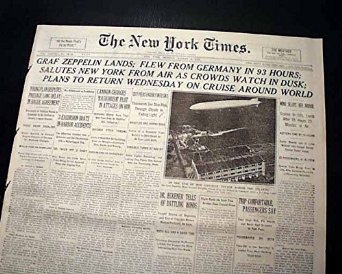
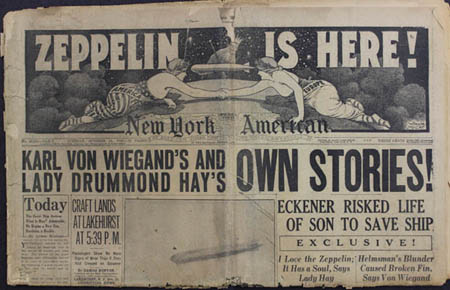
Front page of the “New York Times”, 1929: the Zeppelin “salutes New York from air while crowds watch in dusk”.
“Zeppelin is here! Eckener risked life of son to save ship”, front page of “New York-American”, 1929.
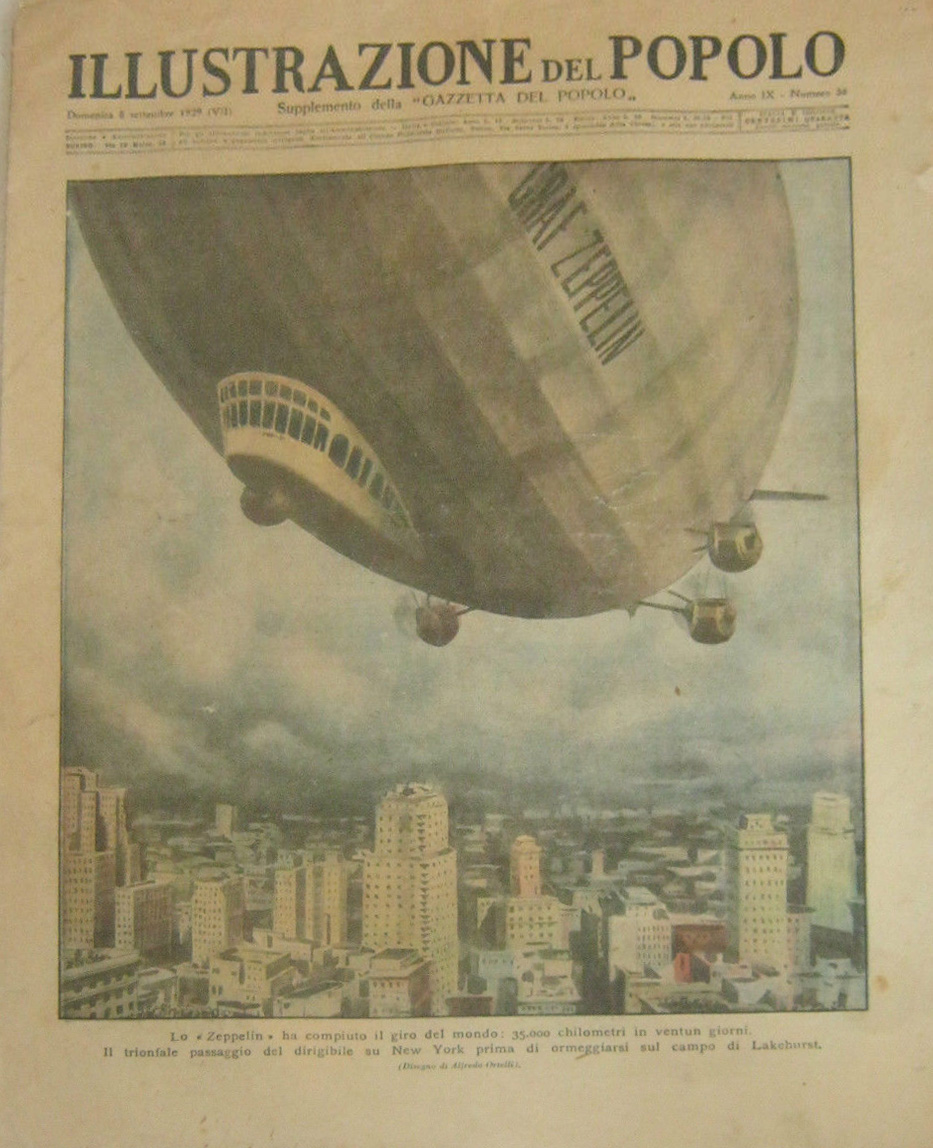
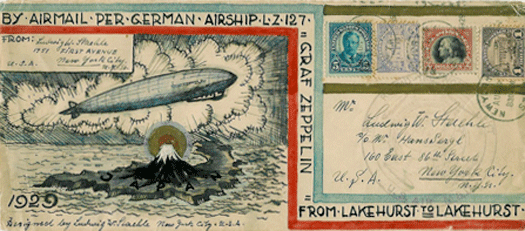
Front cover of “Illustrazione del Popolo” showing the Zeppelin over New York, 1929.
Postcard sent from New York on the Zeppelin’s circumnavigation of the world (1929): the drawing shows the dirigible while it flies over Japan (like the images in Panel C).
After these flights, the public saw Eckener as a hero: he was welcomed to New York by a ‘ticker-tape parade’, and was a guest at the White House. After the 1929 trip around the world, Eckener was nicknamed the “Magellan of the skies”: Warburg’s juxtaposition of the captain of the dirigible with Renaissance men – intellectuals and entrepreneurs, from the astronomer Kepler to Rucellai the merchant – is, therefore, not just the fruit of Warburg’s analytical scrutiny, but a shared perception.
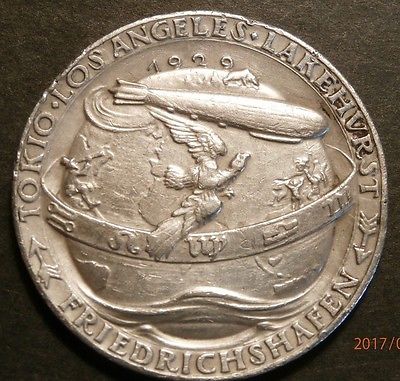
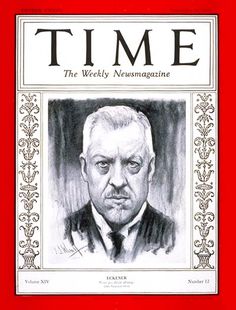
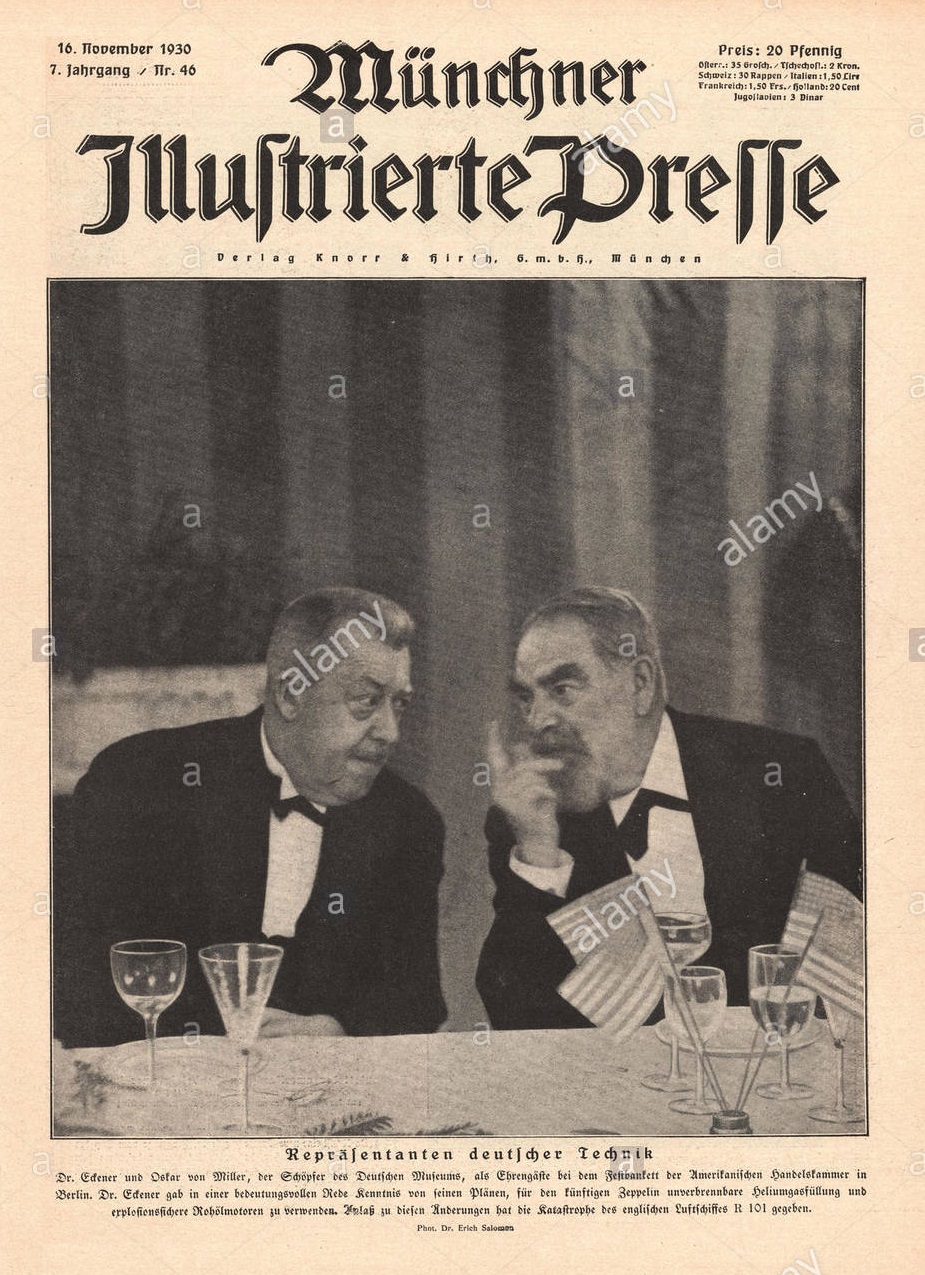
Medal commemorating the Zeppelin’s 1929 Weltreise: the dirigible flies over the earth which is surrounded by a zodiac strip and animated by characters and animals.
Portrait of Eckener on the front page of “Time”, 16 September 1929.
Hugo Eckener and Oskar von Miller, founder of the Munich museum of science, as “representatives of German technology” on the front page of the “Münchner Illustrierte Presse”, 1930.
The Zeppelin’s popularity after these enterprises – also spread by extraordinary filmed scenes of life on board – ensured that the image of the dirigible, as we have already said, would become a veritable fashion: the global circumnavigation became an illustrated card game, and the full bellied shape of the airship lent itself to advertising commercial products, ranging from biscuits to footwear, that had nothing to do with flying.
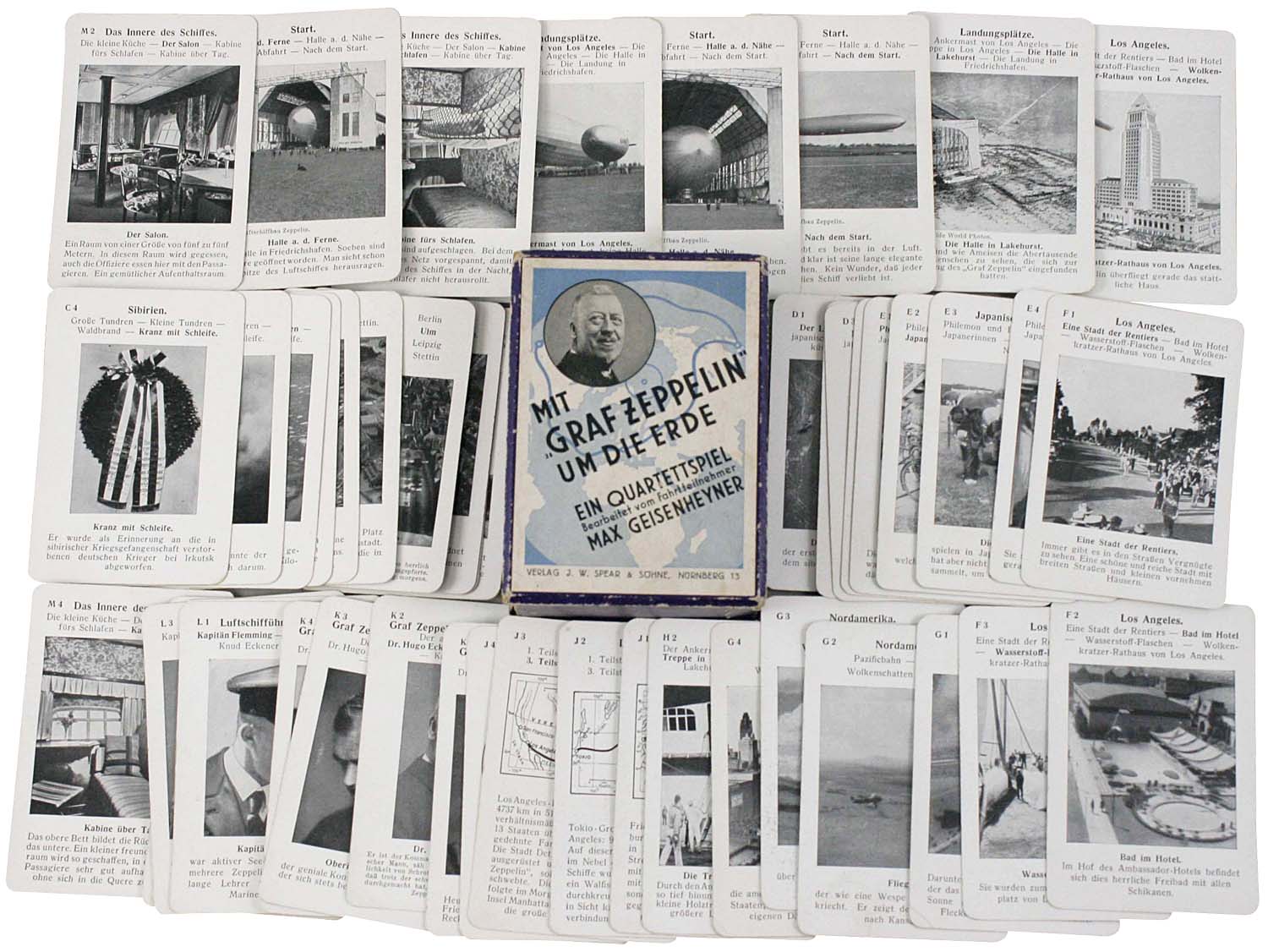
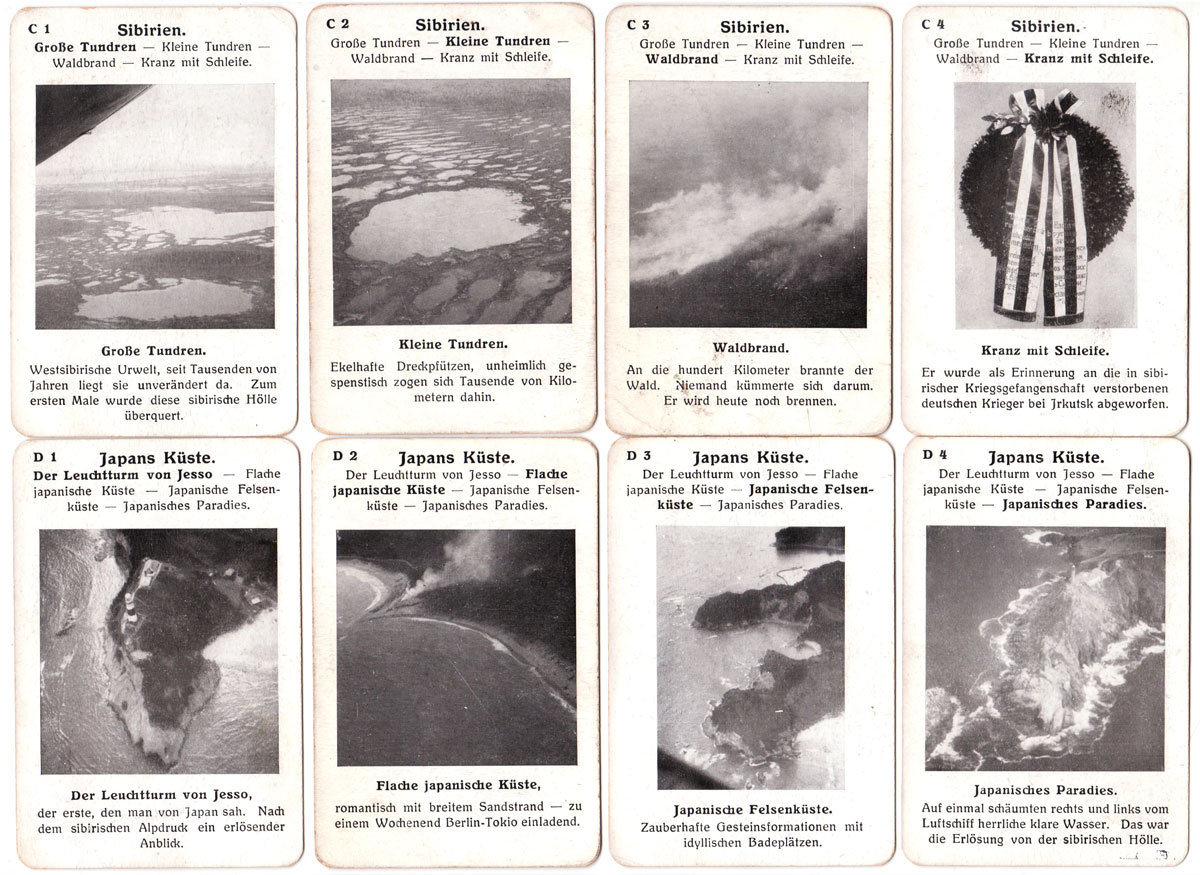
“Around the world with the Graf Zeppelin”, card game (Nuremberg, 1929) taken from the book written by the journalist-passenger Max Geisenheyner: overview and cards with landscapes of Siberia and Japan.
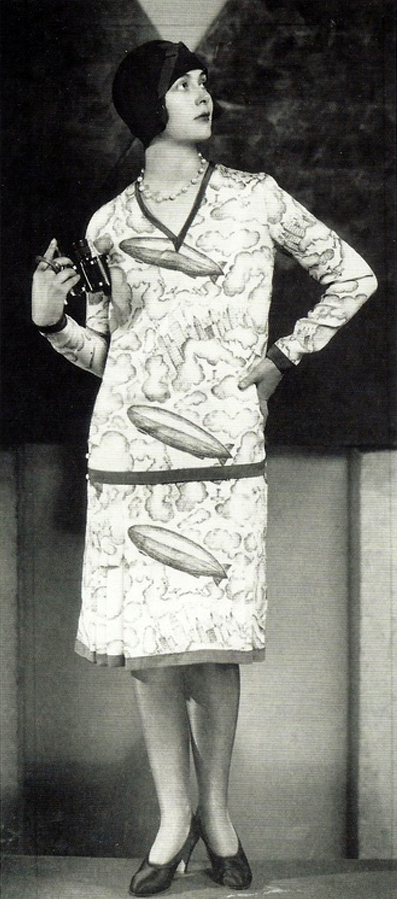
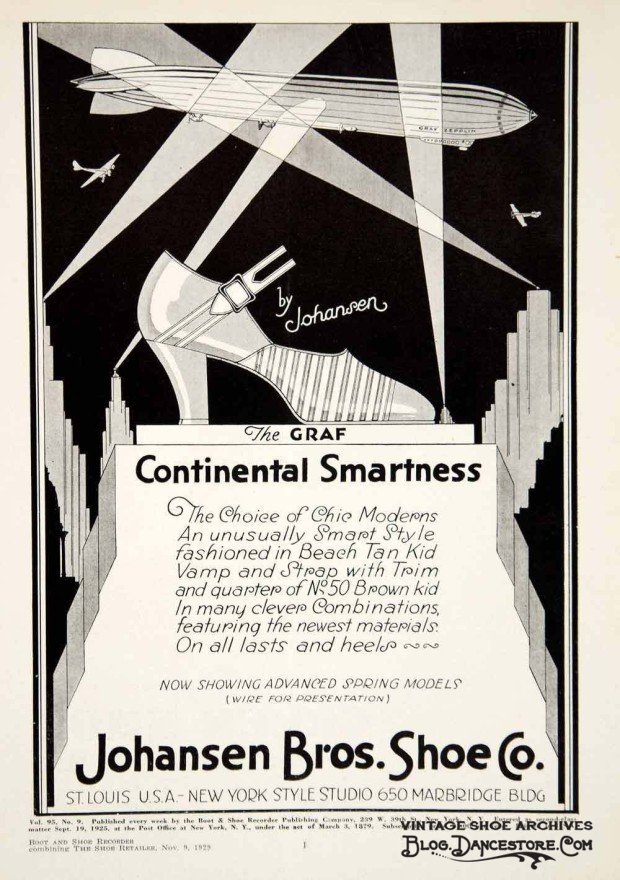
Female outfit made of fabric printed with images of dirigibles, 1920’s.
“Continental Smartness”. American advertisement for women’s footwear model “The Graf”, 1929.
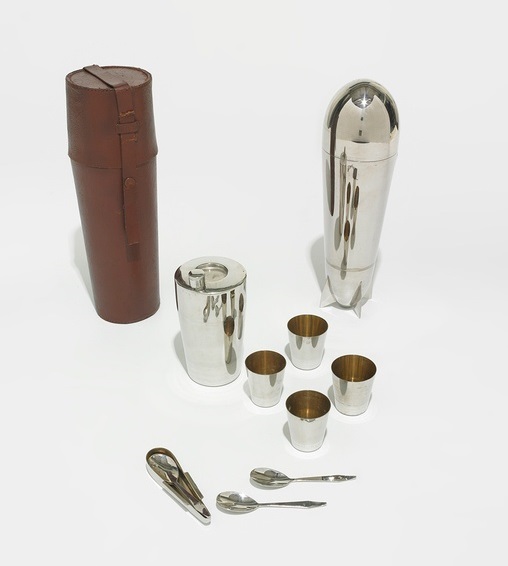
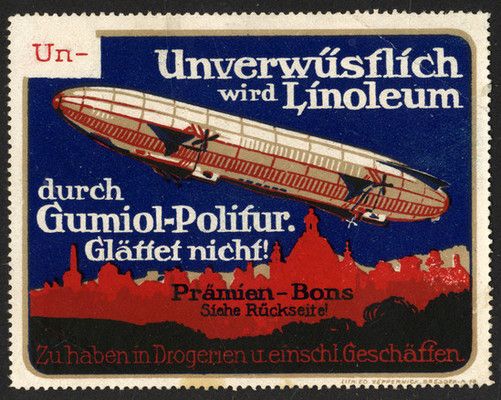
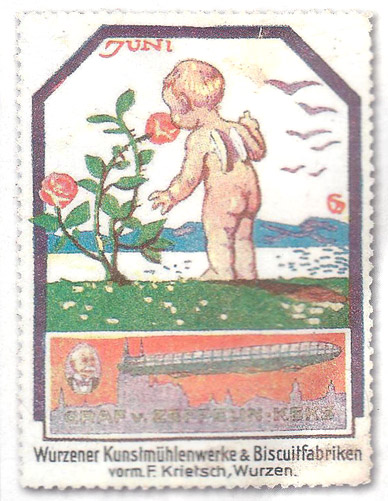
Shaker in the shape of a dirigible, and equipment for preparing cocktails, Germany 1928.
Advertising stamps for linoleum and biscuits.
Zeppelin dirigibles would continue to carry out regular transatlantic flights, especially between Europe and South America, mainly transporting mail.
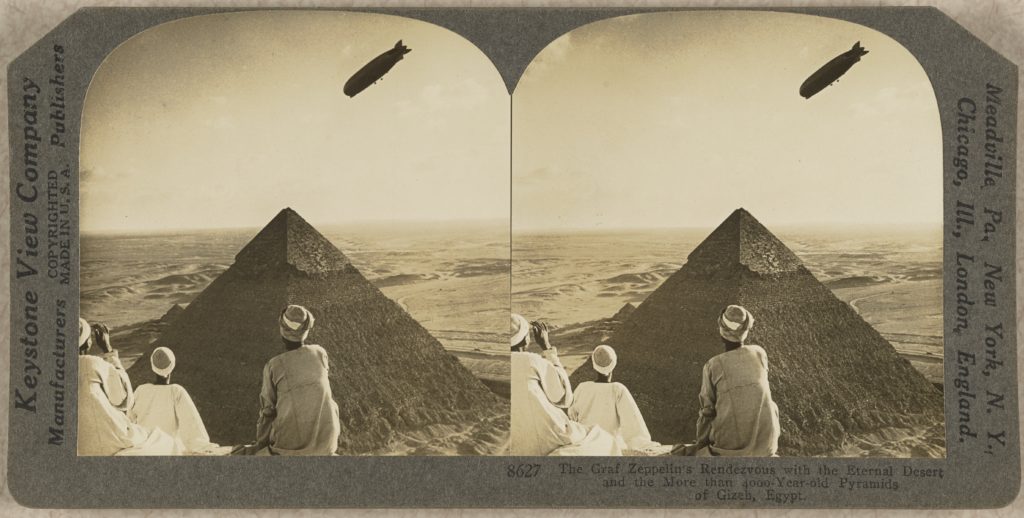
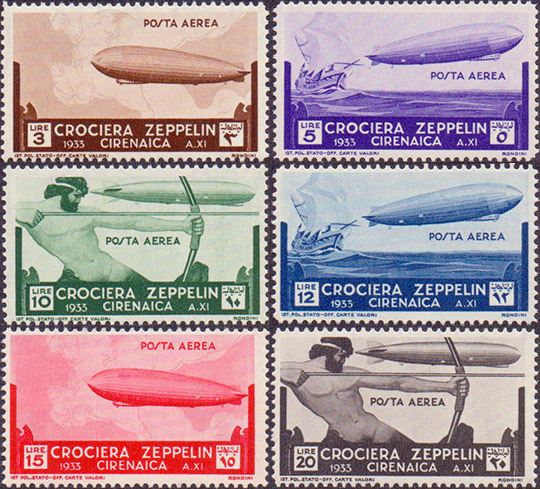
“The Graf Zeppelin’s rendezvous with the Eternal Desert and the more than 4000-years-old Pyramids of Gizeh”: stereograph, 1931.
Air-mail stamps representing the “Zeppelin cruise”, Italy 1933.
The “Hindenburg” disaster of 1937, causing the death of 36 people when the airship exploded on arrival at Lakehurst, in New Jersey, marked the symbolic ending of the “Zeppelin era”: the dirigible gradually fell into disuse, and the Second World War – the new age of Mars – would finally animate the skies with new demons.
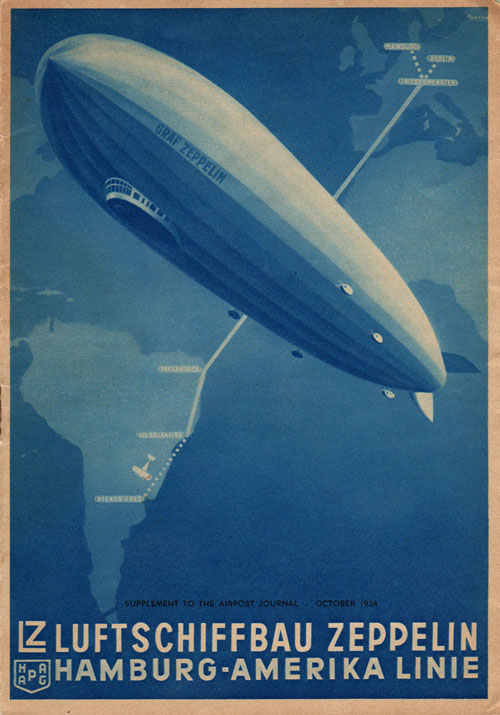
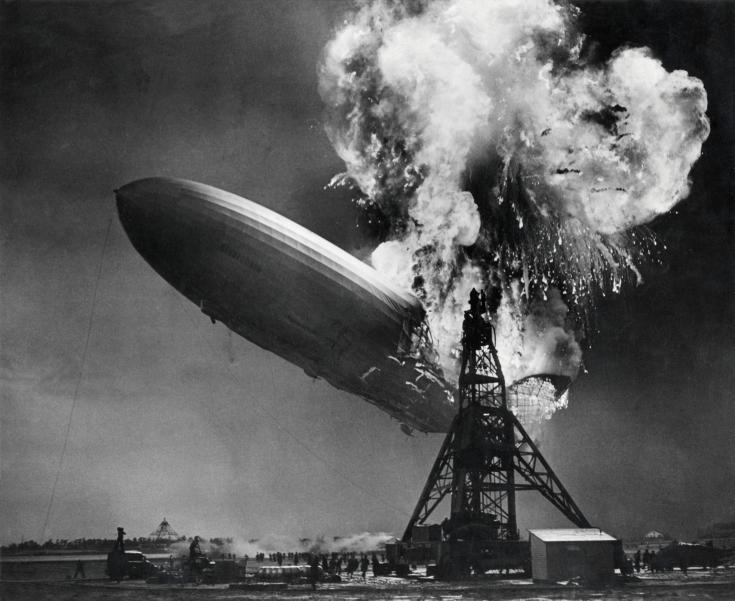
Poster advertising air links between Hamburg and America, October 1934.
The Hindenburg disaster, 6 May, 1937.
Bibliographical references
- Agosti 1984
G. Agosti, Verso Mnemosyne, in G. Agosti, V. Farinella, Calore del marmo. Pratica e tipologia delle deduzioni iconografiche, in “Memoria dell’antico nell’arte italiana. L’uso del classici”, ed. S. Settis, Torino 1984, 441-444. - Calandra 2014
G. Calandra di Roccolino, Aby Warburg architetto. Nota sui progetti per la Kulturwissenschaftliche Bibliothek Warburg ad Amburgo, “La Rivista di Engramma” 116, (maggio 2014). - De Laude 2015
S. De Laude, “Symbol tut wohl!”. Il simbolo fa bene! Genesi del blocco ABC del Bilderatlas Mnemosyne di Aby Warburg, “La Rivista di Engramma” 125 (marzo 2015). - Esposito 2011
F. Esposito, Mythische Moderne. Aviatik, Faschismus und die Sehnsucht nach Ordnung in Deutschland und Italien, München 2011. - Forster [1999] 2002
K.W. Forster, Introduction to Aby Warburg, in A. Warburg, The Renewal of Pagan Antiquity, eds. J. Bloomfield, K.W. Forster, H. Mallgrave, M. Roth, S. Settis, Los Angeles, 1999, 1-75. - Gombrich 1937
E.H. Gombrich, Geburtstagsatlas für Max M. Warburg (5 June 1937), unpublished typescript, WIA (see presentation on the WI webpage). - Gombrich 1970
E.H. Gombrich, Aby Warburg: An Intellectual Biography, The Warburg Institute, University of London, London 1970. - Hensel 2011
T. Hensel, Wie aus der Kunstgeschichte eine Bildwissenschaft wurde. Aby Warburgs Graphien, Berlin 2011. - Kant [1876] 1996
I. Kant, Che cosa significa orientarsi nel pensiero, in F. Volpi (ed.), Kant e l’“Oriente” della ragione, Milano 1996. - Kepler 1609
J. Kepler, Astronomia nova de motibus stellae Martis, Prague 1609. - Saxl [1930] 2002
F. Saxl, Lettera di Fritz Saxl alla casa editrice B.G. Teubner, Lipsia (1930 ca.), in A. Warburg, Mnemosyne. L’Atlante delle immagini, ed. M. Ghelardi, Torino 2002, 137-139. - Seminario Mnemosyne 2011
Seminario Mnemosyne, coordinated by G. Bordignon, M. Centanni, S. Urbini, Fortuna nel Rinascimento. Una lettura di Tavola 48 del Bilderatlas Mnemosyne, “La Rivista di Engramma” 92 (agosto 2011). - Seminario Mnemosyne 2015a
Seminario Mnemosyne, coordinated by M. Centanni, S. De Laude, D. Sacco, S. Urbini, Iter per labyrinthum: le tavole A B C dell’Atlante Mnemosyne, “La Rivista di Engramma” 125 (marzo 2015). - Seminario Mnemosyne 2015d
Seminario Mnemosyne, coordinated by M. Centanni, Figli di Marte. Warburg, Jünger, Brecht, “La Rivista di Engramma” 127 (maggio/giugno 2015). - Stimilli 2013
D. Stimilli, Aby Warburg’s Impresa, “Images re-vues” 4 (2013), Survivance d’Aby Warburg. - Warburg [1913] 1966
A. Warburg, Luftschiff und Tauchboot in der mittelalterlichen Vorstellungswelt (Burgundische Teppiche mit Darstellung der Alexandersage im Palazzo Doria in Rom), “Hamburger Fremdenblatt, Illustrierte Rundschau” 85, 52, 2 marz 1913 (GS I, 241-249; Aeronave e sommergibile nella immaginazione medievale, RPA, 273-282; Renewal, 315-323). - Warburg [1920] 1966
A. Warburg, Heidnisch-antike Weissagung in Wort und Bild zu Luthers Zeiten, “Sitzungsberichte der Heidelberg Akademie der Wissenschaften”, Philosophisch-historische Klasse, Jahrgang 1920, 26, Heidelberg 1920 (GS I, 487-558; Divinazione antica pagana in testi ed immagini dell’età di Lutero, RPA, 309-390; Renewal 597-697; AWO I.2, 85-207). - Warburg [1924] 1998
A. Warburg, Bilder aus dem Gebiet der Pueblo-Indianer in Nord-Amerika, conferenza di Kreuzlingen, aprile 1923 [WIA III.93], tr. A lecture on Serpent Ritual, “Journal of the Warburg Institute” II (April 1939), 277-292; revised edition Schlangenritual. Ein Reisebericht, hgs. U. Raulff, K. Wagenbach, Berlin 1988. - Warburg [1924] [2007] 20143
A. Warburg, Zum Vortrage von Karl Reinhardt über “Ovids Metamorphosen” in der Bibliothek Warburg am 24. Oktober 1924, Hamburg 1924; “Per monstra ad sphaeram”: Vortrag in Gedenken an Franz Boll und andere Schriften 1923 bis 1925, ed. D. Stimilli, Dölling und Galitz, München-Hamburg 2007, Italian tr. Per monstra ad sphaeram, Milano 2014, 39-42. - Warburg [1925] [2007] 20143
A. Warburg, Die Einwirkung der Sphaera Barbarica auf die kosmischen Orientierungsversuche: Franz Boll zum Gedächtnis, April 1925 [WIA III.94.2.1]; version for the Geburtstagsatlas, ed. G. Bing, E.H. Gombrich, F. Saxl, 1937 [WIA III.109]; version ed. P. van Huisstede, De Mnemosyne Beeldatlas van Aby Warburg: een laboratorium voor beeldgeschiedenis, Proefschrift ter verkrijging van de graad van Doctor aan de Rijsuniversiteit te Leiden, 3 Dicember 1992, in www.mnemosyne.org; now in “Per monstra ad sphaeram”: Vortrag in Gedenken an Franz Boll und andere Schriften 1923 bis 1925, ed. D. Stimilli, Dölling und Galitz, München-Hamburg 2007; Italian trans. Per monstra ad sphaeram, Milano, 2014, 43-105. - Warburg [1925] 2012
A.Warburg, L’influsso della Sphaera barbarica sui tentativi di orientamento nel cosmo in Occidente. In memoria di Franz Boll, in Id., Opere, II, La rinascita del paganesimo antico e altri scritti (1917-1929), ed. M. Ghelardi, Torino 2012, 295-396. - Warburg [1926-1929] 2001
A. Warburg, Tagebuch der Kulturwissenschaftlichen Bibliothek Warburg,ed. K. Michels e Ch. Schoell-Glass, Berlin 2001. - Warburg [1927] 2002
A. Warburg, Cosmologia: progetto per una mostra sulla astrologia al Deutsches Museum di Monaco di Baviera, in Id., Opere, II, La rinascita del paganesimo antico e altri scritti (1917-1929), ed. M. Ghelardi, Torino 2012, 691-753. - Warburg [1928] 2012
A. Warburg, Ernst Cassirer: Warum Hamburg den Philosophen Cassirer nicht verlieren darf, “Hamburger Fremdenblatt” 23/06/1928, Italian tr. Perché Amburgo non si può permettere di perdere il filosofo Cassirer, in Id., Opere, II, La rinascita del paganesimo antico e altri scritti (1917-1929), ed. M. Ghelardi, Torino, 2012, 755-764. - Warburg [1932] [1988] 2011
A. Warburg, Die Erneuerung der heidnischen Antike. Kulturwissenschaftliche Beiträge zur Geschichte der europäischen Renaissance, ed. G. Bing und F. Rougemont, Teubner, Leipzig-Berlin 1932 (GS I); ed. H. Bredekamp, M. Diers, Berlin 1998 (Neuauflage, Severus, Hamburg 2011). - Warburg 1993
A. Warburg, Bildersammlung zur Geschichte von Sternglaube und Sternkunde in Hamburger Planetarium, ed. U. Fleckner, R. Galitz, C. Naber e U. Nödelke, Hamburg 1993. - Warburg 20143
A. Warburg, Per monstra ad sphaeram, ed. D. Stimilli and C. Wedepohl, Milano 2014. - Warburg, Cassirer 2003
A. Warburg, E. Cassirer, Il mondo di ieri. Lettere, ed. M. Ghelardi, Torino 2003. - Wedepohl 2013
C. Wedepohl, Panel C, Guided Pathways, in Mnemosyne. Meanderings through Aby Warburg’s Atlas, Warburg.library.cornell.edu, Cornell University 2013. - Wedepohl, Bredekamp 2015
C. Wedepohl, H. Bredekamp, Warburg, Cassirer und Einstein im Gespräch. Kepler als Schlüssel der Moderne, Berlin 2015. - Wind [1971] 1992
E. Wind, review of E.H. Gombrich, Aby Warburg: An Intellectual Biography, “The Times Literary Supplement”, 25 June 1971, 735-736.
Abstract
The essay focuses on Plate C of the Mnemosyne Atlas.
Keywords | Warburg; Mnemosyne Atlas; Plate C.
Per citare questo articolo / To cite this article: Seminario Mnemosyne, Sons of Mars and the heirs of Prometheus – the conquest of the heavens: war and technology. An interpretative essay on Plate C of the Mnemosyne Atlas, “La Rivista di Engramma” n. 144, aprile 2017, pp. 49-83 | PDF
